

How to Write Perfect Persuasive Essays in 5 Simple Steps
WHAT IS A PERSUASIVE ESSAY?

A persuasive text presents a point of view around a topic or theme that is backed by evidence to support it.
The purpose of a persuasive text can be varied. Maybe you intend to influence someone’s opinion on a specific topic, or you might aim to sell a product or service through an advertisement.
The challenge in writing a good persuasive text is to use a mix of emotive language and, in some cases, images that are supported by hard evidence or other people’s opinions.
In a persuasive essay or argument essay, the student strives to convince the reader of the merits of their opinion or stance on a particular issue. The student must utilise several persuasive techniques to form a coherent and logical argument to convince the reader of a point of view or to take a specific action.

PERSUADING PEOPLE REQUIRES A CONSISTENT APPROACH…
Persuasive texts are simple in structure. You must clearly state your opinion around a specific topic and then repeatedly reinforce your opinions with external facts or evidence. A robust concluding summary should leave little doubt in the reader’s mind. ( Please view our planning tool below for a detailed explanation. )
TYPES OF PERSUASIVE TEXT
We cover the broad topic of writing a general persuasive essay in this guide, there are several sub-genres of persuasive texts students will encounter as they progress through school. We have complete guides on these text types, so be sure to click the links and read these in detail if required.
- Argumentative Essays – These are your structured “Dogs are better pets than Cats” opinion-type essays where your role is to upsell the positive elements of your opinions to your audience whilst also highlighting the negative aspects of any opposing views using a range of persuasive language and techniques.
- Advertising – Uses persuasive techniques to sell a good or service to potential customers with a call to action.
- Debating Speeches – A debate is a structured discussion between two teams on a specific topic that a moderator judges and scores. Your role is to state your case, sell your opinions to the audience, and counteract your opposition’s opinions.
- Opinion Articles, Newspaper Editorials. – Editorials often use more subtle persuasive techniques that blur the lines of factual news reporting and opinions that tell a story with bias. Sometimes they may even have a call to action at the end.
- Reviews – Reviews exist to inform others about almost any service or product, such as a film, restaurant, or product. Depending on your experiences, you may have firm opinions or not even care that much about recommending it to others. Either way, you will employ various persuasive techniques to communicate your recommendations to your audience.
- Please note a DISCUSSION essay is not a traditional persuasive text, as even though you are comparing and contrasting elements, the role of the author is to present an unbiased account of both sides so that the reader can make a decision that works best for them. Discussions are often confused as a form of persuasive writing.
A COMPLETE TEACHING UNIT ON PERSUASIVE WRITING SKILLS

Teach your students to produce writing that PERSUADES and INFLUENCES thinking with this HUGE writing guide bundle covering: ⭐ Persuasive Texts / Essays ⭐ Expository Essays⭐ Argumentative Essays⭐ Discussions.
A complete 140 PAGE unit of work on persuasive texts for teachers and students. No preparation is required.
THE STRUCTURE OF A PERSUASIVE ESSAY

1. Introduction
In the introduction, the student will naturally introduce the topic. Controversial issues make for great topics in this writing genre. It’s a cliche in polite society to discourage discussions involving politics, sex, or religion because they can often be very divisive. While these subjects may not be the best topics of conversation for the dinner table at Thanksgiving, they can be perfect when deciding on a topic for persuasive writing. Obviously, the student’s age and abilities should be considered, as well as cultural taboos, when selecting a topic for the essay. But the point holds, the more controversial, the better.
Let’s take a look at some of the critical elements of the introduction when writing a persuasive essay:
Title: Tell your audience what they are reading.
This will often be posed as a question; for example, if the essay is on the merits of a vegetarian lifestyle, it may be called something like: To Eat Meat or Not?
Hook : Provide your audience with a reason to continue reading.
As with any genre of writing, capturing the reader’s interest from the outset is crucial. There are several methods of doing this, known as hooks. Students may open their essays with anecdotes, jokes, quotations, or relevant statistics related to the topic under discussion.
Background: Provide some context to your audience.
In this introductory section, students will provide the reader with some background on the topic. This will place the issue in context and briefly weigh some opinions on the subject.
Thesis statement: Let the audience know your stance.
After surveying the topic in the first part of the introduction, it is now time for the student writer to express their opinion and briefly preview the points they will make later in the essay.
2. Body Paragraphs
The number of paragraphs forming this essay section will depend on the number of points the writer chooses to make to support their opinion. Usually three main points will be sufficient for beginning writers to coordinate. More advanced students can increase the number of paragraphs based on the complexity of their arguments, but the overall structure will largely remain intact.
Be sure to check out our complete guide to writing perfect paragraphs here .
The TEEL acronym is valuable for students to remember how to structure their paragraphs. Read below for a deeper understanding.
Topic Sentence:
The topic sentence states the central point of the paragraph. This will be one of the reasons supporting the thesis statement made in the introduction.
These sentences will build on the topic sentence by illustrating the point further, often by making it more specific.
These sentences’ purpose is to support the paragraph’s central point by providing supporting evidence and examples. This evidence may be statistics, quotations, or anecdotal evidence.
The final part of the paragraph links back to the initial statement of the topic sentence while also forming a bridge to the next point to be made. This part of the paragraph provides some personal analysis and interpretation of how the student arrived at their conclusions and connects the essay as a cohesive whole.
3. Conclusion
The conclusion weaves together the main points of the persuasive essay. It does not usually introduce new arguments or evidence but instead reviews the arguments made already and restates them by summing them up uniquely. It is important at this stage to tie everything back to the initial thesis statement. This is the writer’s last opportunity to drive home their point, to achieve the essay’s goal, to begin with – persuade the reader of their point of view.

Ending an essay well can be challenging, but it is essential to end strongly, especially for persuasive essays. As with the hooks of the essay’s opening, there are many tried and tested methods of leaving the reader with a strong impression. Encourage students to experiment with different endings, for example, concluding the essay with a quotation that amplifies the thesis statement.
Another method is to have the student rework their ending in simple monosyllabic words, as simple language often has the effect of being more decisive in impact. The effect they are striving for in the final sentence is the closing of the circle.
Several persuasive writing techniques can be used in the conclusion and throughout the essay to amp up the persuasive power of the writing. Let’s take a look at a few.
ETHOS, PATHOS & LOGOS TUTORIAL VIDEO (2:20)

TIPS FOR WRITING A GREAT PERSUASIVE ESSAY

PERSUASIVE TECHNIQUES
In this article, we have outlined a basic structure that will be helpful to students in approaching the organization of their persuasive writing. It will also be helpful for the students to be introduced to a few literary techniques that will help your students to present their ideas convincingly. Here are a few of the more common ones:
Repetition: There is a reason why advertisements and commercials are so repetitive – repetition works! Students can use this knowledge to their advantage in their persuasive writing. It is challenging to get the reader to fully agree with the writer’s opinion if they don’t fully understand it. Saying the same thing in various ways ensures the reader gets many bites at the ‘understanding’ cherry.
Repetition Example: “The use of plastic bags is not only bad for the environment, but it is also bad for our economy. Plastic bags are not biodegradable, meaning they will not decompose and will continue to take up space in landfills. Plastic bags are also not recyclable, meaning they will not be reused and will instead end up in landfills. Plastic bags are not only bad for the environment, but they are also bad for our economy as they are costly to dispose of and take up valuable space in landfills.”
In this example, the phrase “not only bad for the environment but also bad for our economy” is repeated multiple times to reinforce the idea that plastic bags are not just a problem for the environment but also the economy. The repetition of the phrase emphasizes the point and makes it more persuasive.
It is also important to note that repetition could be used differently, such as repeating a word or phrase to create rhythm or emphasis.
Storytelling: Humans tend to understand things better through stories. Think of how we teach kids important values through time-tested fables like Peter and the Wolf . Whether through personal anecdotes or references to third-person experiences, stories help climb down the ladder of abstraction and reach the reader on a human level.
Storytelling Example: “Imagine you are walking down the street, and you come across a stray dog clearly in need of food and water. The dog looks up at you with big, sad eyes, and you cannot help but feel a twinge of compassion. Now, imagine that same scenario, but instead of a stray dog, it’s a homeless person sitting on the sidewalk. The person is clearly in need of food and shelter, and their eyes also look up at her with a sense of hopelessness.
The point of this story is to show that just as we feel compelled to help a stray animal in need, we should also feel compelled to help a homeless person. We should not turn a blind eye to the suffering of our fellow human beings, and we should take action to address homelessness in our community. It is important to remember that everyone deserves a roof over their head and a warm meal to eat. The story is designed to elicit an emotional response in the reader and make the argument more relatable and impactful.
By using storytelling, this passage creates an image in the reader’s mind and creates an emotional connection that can be more persuasive than just stating facts and figures.

Dissent: We live in a cynical age, so leaving out the opposing opinion will smack of avoidance to the reader. Encourage your students to turn to that opposing viewpoint and deal with those arguments in their essays .
Dissent Example: “Many people argue that students should not have to wear uniforms in school. They argue that uniforms stifle creativity and individuality and that students should be able to express themselves through their clothing choices. While these are valid concerns, I strongly disagree.
In fact, uniforms can actually promote individuality by levelling the playing field and removing the pressure to dress in a certain way. Furthermore, uniforms can promote a sense of community and belonging within a school. They can also provide a sense of discipline and structure, which can help to create a more focused and productive learning environment. Additionally, uniforms can save families money and eliminate the stress of deciding what to wear daily .
While some may argue that uniforms stifle creativity and individuality, the benefits of uniforms far outweigh the potential drawbacks. It is important to consider the impact of uniforms on the school as a whole, rather than focusing solely on individual expression.”
In this example, the writer presents the opposing viewpoint (uniforms stifle creativity and individuality) and then provides counterarguments to refute it. By doing so, the writer can strengthen their own argument and present a more convincing case for why uniforms should be worn in school.
A Call to Action: A staple of advertising, a call to action can also be used in persuasive writing. When employed, it usually forms part of the conclusion section of the essay and asks the reader to do something, such as recycle, donate to charity, sign a petition etc.
A quick look around reveals to us the power of persuasion, whether in product advertisements, newspaper editorials, or political electioneering; persuasion is an ever-present element in our daily lives. Logic and reason are essential in persuasion, but they are not the only techniques. The dark arts of persuasion can prey on emotion, greed, and bias. Learning to write persuasively can help our students recognize well-made arguments and help to inoculate them against the more sinister manifestations of persuasion.
Call to Action Example: “Climate change is a pressing issue that affects us all, and it’s important that we take action now to reduce our carbon footprint and protect the planet for future generations. As a society, we have the power to make a difference and it starts with small changes that we can make in our own lives.
I urge you to take the following steps to reduce your carbon footprint:
- Reduce your use of single-use plastics
- Use public transportation, carpool, bike or walk instead of driving alone.
- Support clean energy sources such as solar and wind power
- Plant trees and support conservation efforts
It’s easy to feel like one person can’t make a difference, but the truth is that every little bit helps. Together, we can create a more sustainable future for ourselves and for the planet.
So, let’s take action today and make a difference for a better future, it starts with minor changes, but it all adds up and can make a significant impact. We need to take responsibility for our actions and do our part to protect the planet.”
In this example, the writer gives a clear and specific call to action and encourages the reader to take action to reduce their carbon footprint and protect the planet. By doing this, the writer empowers the reader to take action and enables them to change.
Now, go persuade your students of the importance of perfecting the art of persuasive writing!
A COMPLETE UNIT ON TEACHING FACT AND OPINION

This HUGE 120 PAGE resource combines four different fact and opinion activities you can undertake as a WHOLE GROUP or as INDEPENDENT READING GROUP TASKS in either DIGITAL or PRINTABLE TASKS.
20 POPULAR PERSUASIVE ESSAY TOPICS FOR STUDENTS
Writing an effective persuasive essay demonstrates a range of skills that will be of great use in nearly all aspects of life after school.

In essence, if you can influence a person to change their ideas or thoughts on a given topic through how you structure your words and thoughts, you possess a very powerful skill.
Be careful not to rant wildly. Use facts and other people’s ideas who think similarly to you in your essay to strengthen your concepts.
Your biggest challenge in getting started may be choosing a suitable persuasive essay topic. These 20 topics for a persuasive essay should make this process a little easier.
- WHY ARE WE FASCINATED WITH CELEBRITIES AND WEALTHY PEOPLE ON TELEVISION AND SOCIAL MEDIA?
- IS IT RIGHT FOR SCHOOLS TO RAISE MONEY BY SELLING CANDY AND UNHEALTHY FOODS TO STUDENTS?
- SHOULD GIRLS BE ALLOWED TO PLAY ON BOYS SPORTING TEAMS?
- IS TEACHING HANDWRITING A WASTE OF TIME IN THIS DAY AND AGE?
- SHOULD THERE BE FAR GREATER RESTRICTIONS AROUND WHAT CAN BE POSTED ON THE INTERNET?
- SHOULD PROFESSIONAL ATHLETES HAVE TO TAKE DRUG TESTS?
- ARE TEENAGE PREGNANCY SHOWS A NEGATIVE OR POSITIVE INFLUENCE ON VIEWERS?
- SHOULD GAMBLING BE PROMOTED IN ANY WAY IN SPORTS EVEN THOUGH IT BRINGS IN LARGE AMOUNTS OF REVENUE?
- SHOULD SPORTING TEAMS THAT LOSE BE REWARDED BY RECEIVING INCENTIVES SUCH AS HIGH DRAFT PICKS AND / OR FINANCIAL BENEFITS?
- SHOULD SHARKS THAT ATTACK PEOPLE BE DESTROYED? SHOULD WE GET INVOLVED IN FOREIGN CONFLICTS AND ISSUES THAT DON’T DIRECTLY AFFECT OUR COUNTRY?
- SHOULD WE GET INVOLVED IN FOREIGN CONFLICTS AND ISSUES THAT DON’T DIRECTLY AFFECT OUR COUNTRY?
- COULD VIDEO GAMES BE CONSIDERED AS A PROFESSIONAL SPORT?
- IF YOU WERE THE LEADER OF YOUR COUNTRY AND HAD A LARGE SURPLUS TO SPEND, WHAT WOULD YOU DO WITH IT?
- WHEN SHOULD A PERSON BE CONSIDERED AND TREATED AS AN ADULT?
- SHOULD SMOKING BECOME AN ILLEGAL ACTIVITY?
- SHOULD THE VOTING AGE BE LOWERED?
- DOES PROTECTIVE PADDING IN SPORTS MAKE IT MORE DANGEROUS?
- SHOULD CELL PHONES BE ALLOWED IN THE CLASSROOM?
- IS TEACHING A FOREIGN LANGUAGE A WASTE OF TIME?
- SHOULD WE TEACH ETIQUETTE IN SCHOOLS?
PERSUASIVE PROMPTS FOR RELUCTANT WRITERS
If your students need a little more direction and guidance, here are some journal prompts that include aspects to consider.
- Convince us that students would be better off having a three-day weekend . There are many angles you could take with this, such as letting children maximize their childhood or trying to convince your audience that a four-day school week might actually be more productive.
- Which is the best season? And why? You will really need to draw on the benefits of your preferred season and sell them to your audience. Where possible, highlight the negatives of the competing seasons. Use lots of figurative language and sensory and emotional connections for this topic.
- Aliens do / or don’t exist? We can see millions of stars surrounding us just by gazing into the night sky, suggesting alien life should exist, right? Many would argue that if there were aliens we would have seen tangible evidence of them by now. The only fact is that we just don’t know the answer to this question. It is your task to try and convince your audience through some research and logic what your point of view is and why.
- Should school uniforms be mandatory? Do your research on this popular and divisive topic and make your position clear on where you stand and why. Use plenty of real-world examples to support your thoughts and points of view.
- Should Smartphones be banned in schools? Whilst this would be a complete nightmare for most students’ social lives, maybe it might make schools more productive places for students to focus and learn. Pick a position, have at least three solid arguments to support your point of view, and sell them to your audience.
VISUAL JOURNAL PROMPTS FOR PERSUASIVE WRITING
Try these engaging, persuasive prompts with your students to ignite the writing process . Scroll through them.

Persuasive Essay Examples (Student Writing Samples)
Below are a collection of persuasive essay samples. Click on the image to enlarge and explore them in greater detail. Please take a moment to read the persuasive texts in detail and the teacher and student guides highlight some of the critical elements of writing a persuasion.
Please understand these student writing samples are not intended to be perfect examples for each age or grade level but a piece of writing for students and teachers to explore together to critically analyze to improve student writing skills and deepen their understanding of persuasive text writing.
We recommend reading the example either a year above or below, as well as the grade you are currently working with, to gain a broader appreciation of this text type.

VIDEO TUTORIALS FOR PERSUASIVE WRITING

OTHER GREAT ARTICLES RELATED TO PERSUASIVE ESSAY WRITING

Teaching Resources
Use our resources and tools to improve your student’s writing skills through proven teaching strategies.
WHERE CAN I FIND A COMPLETE UNIT OF WORK ON HOW TO WRITE PERSUASIVE ESSAYS?

We pride ourselves on being the web’s best resource for teaching students and teachers how to write a persuasive text. We value the fact you have taken the time to read our comprehensive guides to understand the fundamentals of writing skills.
We also understand some of you just don’t have the luxury of time or the resources to create engaging resources exactly when you need them.
If you are time-poor and looking for an in-depth solution that encompasses all of the concepts outlined in this article, I strongly recommend looking at the “ Writing to Persuade and Influence Unit. ”
Working in partnership with Innovative Teaching Ideas , we confidently recommend this resource as an all-in-one solution to teach how to write persuasively.
This unit will find over 140 pages of engaging and innovative teaching ideas.
PERSUASIVE ESSAY WRITING CHECKLIST AND RUBRIC BUNDLE

The Ultimate Guide to Opinion Writing for Students and Teachers

Top 5 Persuasive Writing Techniques for Students

5 Top Persuasive Writing Lesson Plans for Students and Teachers

23 Persuasive writing Topics for High School students

How to Write an Advertisement: A Complete Guide for Students and Teachers

How to Start an Essay with Strong Hooks and Leads
How to Write a Persuasive Essay for Middle School
David raudenbush, 26 sep 2017.

Because most states require persuasive writing in their curriculum standards, this writing genre pops up frequently during the middle school years. Students need to know how to take a stance on a topic, gather supporting evidence and structure an argument in essay form. With a blend of strong content and logical organization, a student can make a convincing argument on topics assigned in class and on standardized tests.
Explore this article
- Planning and Research
- The Introduction
- The Closing
1 Planning and Research
Persuasive writing requires taking a side on a controversial topic and convincing readers to join that side. In the essay, middle school students might argue for changing the school lunch menu, for example. After choosing a position, the student gathers supporting evidence including relevant facts, interesting statistics, quotes from experts and personal anecdotes. On a timed writing test, a student may have to rely on given information or prior knowledge for evidence. On a long-term assignment, students can use library and Internet research along with interviewing knowledgeable experts. For example, a student writing to convince the administration to improve school lunches could get statistics from the Food and Drug Administration website, facts from a nutrition book in the library and expert quotes from the school's home economics teacher as evidence.
2 The Introduction
The first few sentences should grab the readers’ attention with vivid word choices and figurative language that sets a tone. The introductory paragraph clearly introduces the essay's topic and in most middle school essays, it ends with a thesis sentence stating the writer’s position on the topic. For example, the thesis might say “Middle school students should be provided cafeteria lunches that appeal to the tastes of young teenagers and provide a nutritious meal.”
Each paragraph begins with a topic sentence that clearly states one reason why the reader should agree with the student's claim. The rest of the paragraph presents supporting evidence from the research that elaborates on the topic sentence. For the school lunch topic, a paragraph might focus on comparing the calories, fat and sodium content of current school lunches with healthier alternatives using statistical information. The next paragraph could discuss how healthier food can also taste better using quotes from a home economics teacher. Some persuasive writing assignments require middle school students to include a rebuttal paragraph in which the writer anticipates possible counter claims against the thesis and uses evidence to explain why the counter claims are not valid.
4 The Closing
The closing is the last chance the student has to make a memorable statement about the topic that will convince the reader to think or act differently, focusing on a call to action in a sentence or two that states the change the student has argued for in the essay. For example, a persuasive essay about cafeteria food could end with "The principal and school board should require the middle school cafeteria to revise its menu to reflect healthy choices that will also be popular with students who eat there every day."
- 1 Read Write Think: Developing Persuasive Strategies
About the Author
David Raudenbush has more than 20 years of experience as a literacy teacher, staff developer and literacy coach. He has written for newspapers, magazines and online publications, and served as the editor of "Golfstyles New Jersey Magazine." Raudenbush holds a bachelor's degree in journalism and a master's degree in education.
Related Articles

Sandwich Method of Paragraph Writing

Middle School Essay Types

How to Build a Thesis for a College Essay

How to Start the Introduction in a Group Presentation

Persuasive Writing Topics

Types of Introductions in Essays

How to Make a Good Introduction Paragraph

How to Write an Introduction for an Economics Essay

Persuasive Writing Topics for 5th Grade

How to Write a Negative Debate Speech

How to Start an Informative Paper

How to Write an Excellent Formal Essay

How to Conduct a Debate in Fifth Grade

How to Write a Policy Report

Topics for Problem-Solution Essays

Rules for Classroom Debates

How to Write an Essay on Encouraging Students to Volunteer

The Difference Between Discursive & Argumentative Essays

How to Word a Lunch Party Invitation

How to Write an Invitation for a Gathering Following...
Regardless of how old we are, we never stop learning. Classroom is the educational resource for people of all ages. Whether you’re studying times tables or applying to college, Classroom has the answers.
- Accessibility
- Terms of Use
- Privacy Policy
- Copyright Policy
- Manage Preferences
© 2020 Leaf Group Ltd. / Leaf Group Media, All Rights Reserved. Based on the Word Net lexical database for the English Language. See disclaimer .
Can You Convince Me? Developing Persuasive Writing

- Resources & Preparation
- Instructional Plan
- Related Resources
Persuasive writing is an important skill that can seem intimidating to elementary students. This lesson encourages students to use skills and knowledge they may not realize they already have. A classroom game introduces students to the basic concepts of lobbying for something that is important to them (or that they want) and making persuasive arguments. Students then choose their own persuasive piece to analyze and learn some of the definitions associated with persuasive writing. Once students become aware of the techniques used in oral arguments, they then apply them to independent persuasive writing activities and analyze the work of others to see if it contains effective persuasive techniques.
Featured Resources
From theory to practice.
- Students can discover for themselves how much they already know about constructing persuasive arguments by participating in an exercise that is not intimidating.
- Progressing from spoken to written arguments will help students become better readers of persuasive texts.
Common Core Standards
This resource has been aligned to the Common Core State Standards for states in which they have been adopted. If a state does not appear in the drop-down, CCSS alignments are forthcoming.
State Standards
This lesson has been aligned to standards in the following states. If a state does not appear in the drop-down, standard alignments are not currently available for that state.
NCTE/IRA National Standards for the English Language Arts
- 4. Students adjust their use of spoken, written, and visual language (e.g., conventions, style, vocabulary) to communicate effectively with a variety of audiences and for different purposes.
- 5. Students employ a wide range of strategies as they write and use different writing process elements appropriately to communicate with different audiences for a variety of purposes.
Materials and Technology
- Computers with Internet access
- PowerPoint
- LCD projector (optional)
- Chart paper or chalkboard
- Sticky notes
- Persuasive Strategy Presentation
- Persuasion Is All Around You
- Persuasive Strategy Definitions
- Check the Strategies
- Check the Strategy
- Observations and Notes
- Persuasive Writing Assessment
Preparation
Student objectives.
Students will
- Work in cooperative groups to brainstorm ideas and organize them into a cohesive argument to be presented to the class
- Gain knowledge of the different strategies that are used in effective persuasive writing
- Use a graphic organizer to help them begin organizing their ideas into written form
- Apply what they have learned to write a persuasive piece that expresses their stance and reasoning in a clear, logical sequence
- Develop oral presentation skills by presenting their persuasive writing pieces to the class
- Analyze the work of others to see if it contains effective persuasive techniques
Session 1: The Game of Persuasion
Home/School Connection: Distribute Persuasion Is All Around You . Students are to find an example of a persuasive piece from the newspaper, television, radio, magazine, or billboards around town and be ready to report back to class during Session 2. Provide a selection of magazines or newspapers with advertisements for students who may not have materials at home. For English-language learners (ELLs), it may be helpful to show examples of advertisements and articles in newspapers and magazines.
Session 2: Analysis of an Argument
Home/School Connection: Ask students to revisit their persuasive piece from Persuasion Is All Around You . This time they will use Check the Strategies to look for the persuasive strategies that the creator of the piece incorporated. Check for understanding with your ELLs and any special needs students. It may be helpful for them to talk through their persuasive piece with you or a peer before taking it home for homework. Arrange a time for any student who may not have the opportunity to complete assignments outside of school to work with you, a volunteer, or another adult at school on the assignment.
Session 3: Persuasive Writing
Session 4: presenting the persuasive writing.
- Endangered Species: Persuasive Writing offers a way to integrate science with persuasive writing. Have students pretend that they are reporters and have to convince people to think the way they do. Have them pick issues related to endangered species, use the Persuasion Map as a prewriting exercise, and write essays trying to convince others of their points of view. In addition, the lesson “Persuasive Essay: Environmental Issues” can be adapted for your students as part of this exercise.
- Have students write persuasive arguments for a special class event, such as an educational field trip or an in-class educational movie. Reward the class by arranging for the class event suggested in one of the essays.
Student Assessment / Reflections
- Compare your Observations and Notes from Session 4 and Session 1 to see if students understand the persuasive strategies, use any new persuasive strategies, seem to be overusing a strategy, or need more practice refining the use of a strategy. Offer them guidance and practice as needed.
- Collect both homework assignments and the Check the Strategy sheets and assess how well students understand the different elements of persuasive writing and how they are applied.
- Collect students’ Persuasion Maps and use them and your discussions during conferences to see how well students understand how to use the persuasive strategies and are able to plan their essays. You want to look also at how well they are able to make changes from the map to their finished essays.
- Use the Persuasive Writing Assessment to evaluate the essays students wrote during Session 3.
- Calendar Activities
- Strategy Guides
- Lesson Plans
- Student Interactives
The Persuasion Map is an interactive graphic organizer that enables students to map out their arguments for a persuasive essay or debate.
This interactive tool allows students to create Venn diagrams that contain two or three overlapping circles, enabling them to organize their information logically.
- Print this resource
Explore Resources by Grade
- Kindergarten K
Get 25% OFF new yearly plans in our Spring Sale
- Features for Creative Writers
- Features for Work
- Features for Higher Education
- Features for Teachers
- Features for Non-Native Speakers
- Learn Blog Grammar Guide Community Events FAQ
- Grammar Guide
How to Write a Persuasive Essay: Tips and Tricks

Allison Bressmer

Most composition classes you’ll take will teach the art of persuasive writing. That’s a good thing.
Knowing where you stand on issues and knowing how to argue for or against something is a skill that will serve you well both inside and outside of the classroom.
Persuasion is the art of using logic to prompt audiences to change their mind or take action , and is generally seen as accomplishing that goal by appealing to emotions and feelings.
A persuasive essay is one that attempts to get a reader to agree with your perspective.

Ready for some tips on how to produce a well-written, well-rounded, well-structured persuasive essay? Just say yes. I don’t want to have to write another essay to convince you!
How Do I Write a Persuasive Essay?
What are some good topics for a persuasive essay, how do i identify an audience for my persuasive essay, how do you create an effective persuasive essay, how should i edit my persuasive essay.
Your persuasive essay needs to have the three components required of any essay: the introduction , body , and conclusion .
That is essay structure. However, there is flexibility in that structure.
There is no rule (unless the assignment has specific rules) for how many paragraphs any of those sections need.
Although the components should be proportional; the body paragraphs will comprise most of your persuasive essay.

How Do I Start a Persuasive Essay?
As with any essay introduction, this paragraph is where you grab your audience’s attention, provide context for the topic of discussion, and present your thesis statement.
TIP 1: Some writers find it easier to write their introductions last. As long as you have your working thesis, this is a perfectly acceptable approach. From that thesis, you can plan your body paragraphs and then go back and write your introduction.
TIP 2: Avoid “announcing” your thesis. Don’t include statements like this:
- “In my essay I will show why extinct animals should (not) be regenerated.”
- “The purpose of my essay is to argue that extinct animals should (not) be regenerated.”
Announcements take away from the originality, authority, and sophistication of your writing.
Instead, write a convincing thesis statement that answers the question "so what?" Why is the topic important, what do you think about it, and why do you think that? Be specific.
How Many Paragraphs Should a Persuasive Essay Have?
This body of your persuasive essay is the section in which you develop the arguments that support your thesis. Consider these questions as you plan this section of your essay:
- What arguments support your thesis?
- What is the best order for your arguments?
- What evidence do you have?
- Will you address the opposing argument to your own?
- How can you conclude convincingly?

TIP: Brainstorm and do your research before you decide which arguments you’ll focus on in your discussion. Make a list of possibilities and go with the ones that are strongest, that you can discuss with the most confidence, and that help you balance your rhetorical triangle .
What Should I Put in the Conclusion of a Persuasive Essay?
The conclusion is your “mic-drop” moment. Think about how you can leave your audience with a strong final comment.
And while a conclusion often re-emphasizes the main points of a discussion, it shouldn’t simply repeat them.
TIP 1: Be careful not to introduce a new argument in the conclusion—there’s no time to develop it now that you’ve reached the end of your discussion!
TIP 2 : As with your thesis, avoid announcing your conclusion. Don’t start your conclusion with “in conclusion” or “to conclude” or “to end my essay” type statements. Your audience should be able to see that you are bringing the discussion to a close without those overused, less sophisticated signals.

If your instructor has assigned you a topic, then you’ve already got your issue; you’ll just have to determine where you stand on the issue. Where you stand on your topic is your position on that topic.
Your position will ultimately become the thesis of your persuasive essay: the statement the rest of the essay argues for and supports, intending to convince your audience to consider your point of view.
If you have to choose your own topic, use these guidelines to help you make your selection:
- Choose an issue you truly care about
- Choose an issue that is actually debatable
Simple “tastes” (likes and dislikes) can’t really be argued. No matter how many ways someone tries to convince me that milk chocolate rules, I just won’t agree.
It’s dark chocolate or nothing as far as my tastes are concerned.
Similarly, you can’t convince a person to “like” one film more than another in an essay.
You could argue that one movie has superior qualities than another: cinematography, acting, directing, etc. but you can’t convince a person that the film really appeals to them.

Once you’ve selected your issue, determine your position just as you would for an assigned topic. That position will ultimately become your thesis.
Until you’ve finalized your work, consider your thesis a “working thesis.”
This means that your statement represents your position, but you might change its phrasing or structure for that final version.
When you’re writing an essay for a class, it can seem strange to identify an audience—isn’t the audience the instructor?
Your instructor will read and evaluate your essay, and may be part of your greater audience, but you shouldn’t just write for your teacher.
Think about who your intended audience is.
For an argument essay, think of your audience as the people who disagree with you—the people who need convincing.
That population could be quite broad, for example, if you’re arguing a political issue, or narrow, if you’re trying to convince your parents to extend your curfew.
Once you’ve got a sense of your audience, it’s time to consult with Aristotle. Aristotle’s teaching on persuasion has shaped communication since about 330 BC. Apparently, it works.

Aristotle taught that in order to convince an audience of something, the communicator needs to balance the three elements of the rhetorical triangle to achieve the best results.
Those three elements are ethos , logos , and pathos .
Ethos relates to credibility and trustworthiness. How can you, as the writer, demonstrate your credibility as a source of information to your audience?
How will you show them you are worthy of their trust?

- You show you’ve done your research: you understand the issue, both sides
- You show respect for the opposing side: if you disrespect your audience, they won’t respect you or your ideas
Logos relates to logic. How will you convince your audience that your arguments and ideas are reasonable?

You provide facts or other supporting evidence to support your claims.
That evidence may take the form of studies or expert input or reasonable examples or a combination of all of those things, depending on the specific requirements of your assignment.
Remember: if you use someone else’s ideas or words in your essay, you need to give them credit.
ProWritingAid's Plagiarism Checker checks your work against over a billion web-pages, published works, and academic papers so you can be sure of its originality.
Find out more about ProWritingAid’s Plagiarism checks.
Pathos relates to emotion. Audiences are people and people are emotional beings. We respond to emotional prompts. How will you engage your audience with your arguments on an emotional level?

- You make strategic word choices : words have denotations (dictionary meanings) and also connotations, or emotional values. Use words whose connotations will help prompt the feelings you want your audience to experience.
- You use emotionally engaging examples to support your claims or make a point, prompting your audience to be moved by your discussion.
Be mindful as you lean into elements of the triangle. Too much pathos and your audience might end up feeling manipulated, roll their eyes and move on.
An “all logos” approach will leave your essay dry and without a sense of voice; it will probably bore your audience rather than make them care.
Once you’ve got your essay planned, start writing! Don’t worry about perfection, just get your ideas out of your head and off your list and into a rough essay format.
After you’ve written your draft, evaluate your work. What works and what doesn’t? For help with evaluating and revising your work, check out this ProWritingAid post on manuscript revision .
After you’ve evaluated your draft, revise it. Repeat that process as many times as you need to make your work the best it can be.
When you’re satisfied with the content and structure of the essay, take it through the editing process .
Grammatical or sentence-level errors can distract your audience or even detract from the ethos—the authority—of your work.
You don’t have to edit alone! ProWritingAid’s Realtime Report will find errors and make suggestions for improvements.
You can even use it on emails to your professors:

Try ProWritingAid with a free account.
How Can I Improve My Persuasion Skills?
You can develop your powers of persuasion every day just by observing what’s around you.
- How is that advertisement working to convince you to buy a product?
- How is a political candidate arguing for you to vote for them?
- How do you “argue” with friends about what to do over the weekend, or convince your boss to give you a raise?
- How are your parents working to convince you to follow a certain academic or career path?
As you observe these arguments in action, evaluate them. Why are they effective or why do they fail?
How could an argument be strengthened with more (or less) emphasis on ethos, logos, and pathos?
Every argument is an opportunity to learn! Observe them, evaluate them, and use them to perfect your own powers of persuasion.

Be confident about grammar
Check every email, essay, or story for grammar mistakes. Fix them before you press send.
Allison Bressmer is a professor of freshman composition and critical reading at a community college and a freelance writer. If she isn’t writing or teaching, you’ll likely find her reading a book or listening to a podcast while happily sipping a semi-sweet iced tea or happy-houring with friends. She lives in New York with her family. Connect at linkedin.com/in/allisonbressmer.
Get started with ProWritingAid
Drop us a line or let's stay in touch via :
- Grades 6-12
- School Leaders
FREE Poetry Worksheet Bundle! Perfect for National Poetry Month.
101 Interesting Persuasive Essay Topics for Kids and Teens
Use your words to sway the reader.
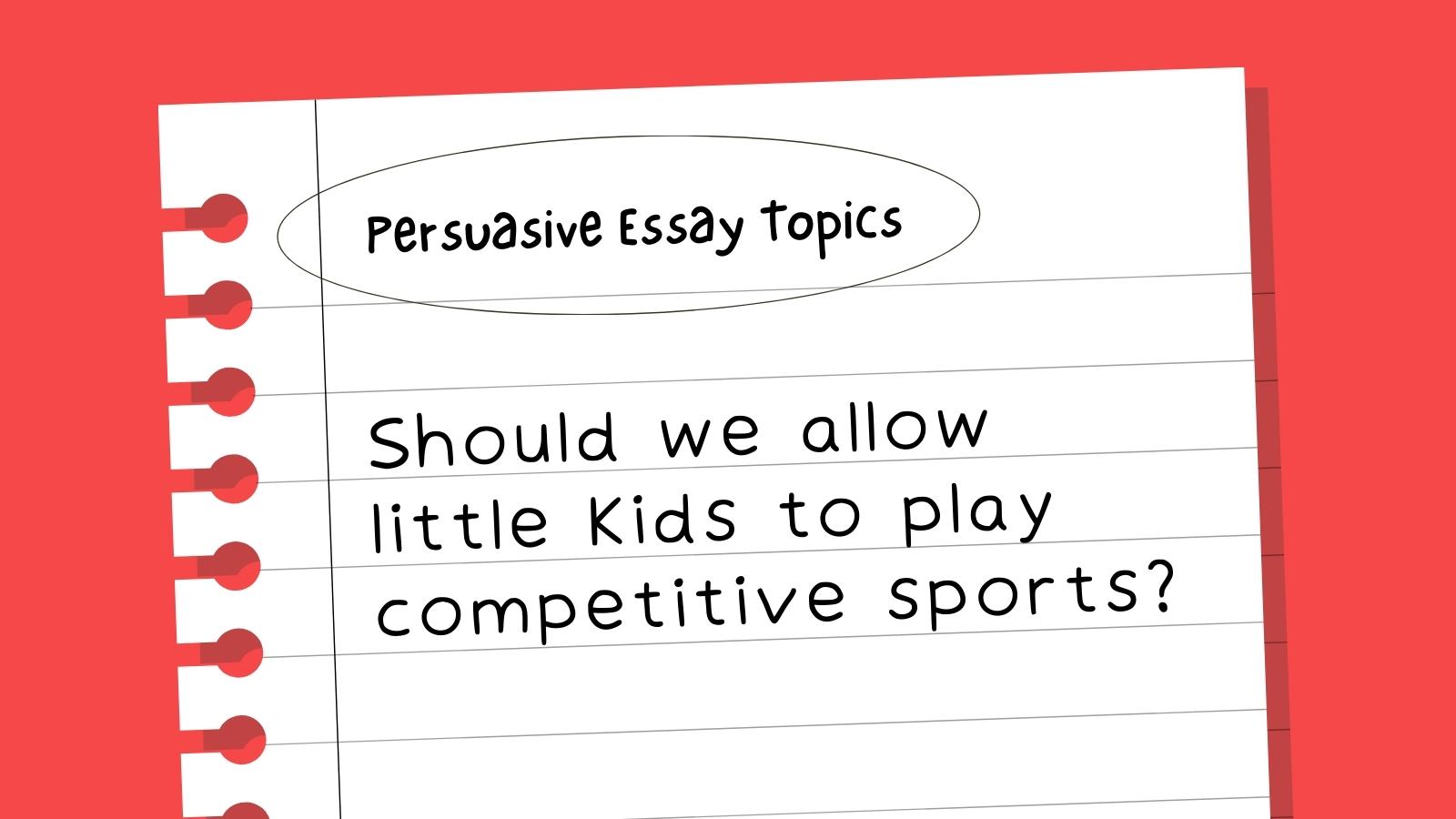
Persuasive writing is one of those skills that can help students succeed in real life. Persuasive essays are similar to argumentative , but they rely less on facts and more on emotion to sway the reader. It’s important to know your audience so you can anticipate any counterarguments they might make and try to overcome them. Try reading some mentor texts to show kids great examples of opinion writing. Then use these persuasive essay topics for practice.
School and Education Persuasive Essay Topics
Life and ethics persuasive essay topics, science and technology persuasive essay topics, sports and entertainment persuasive essay topics, just for fun persuasive essay topics.
- Do you think homework should be required, optional, or not given at all?

- Students should/should not be able to use their phones during the school day.
- Should schools have dress codes?
- If I could change one school rule, it would be …
- Is year-round school a good idea?
- Should we stop giving final exams?
- Is it better to be good at academics or good at sports?
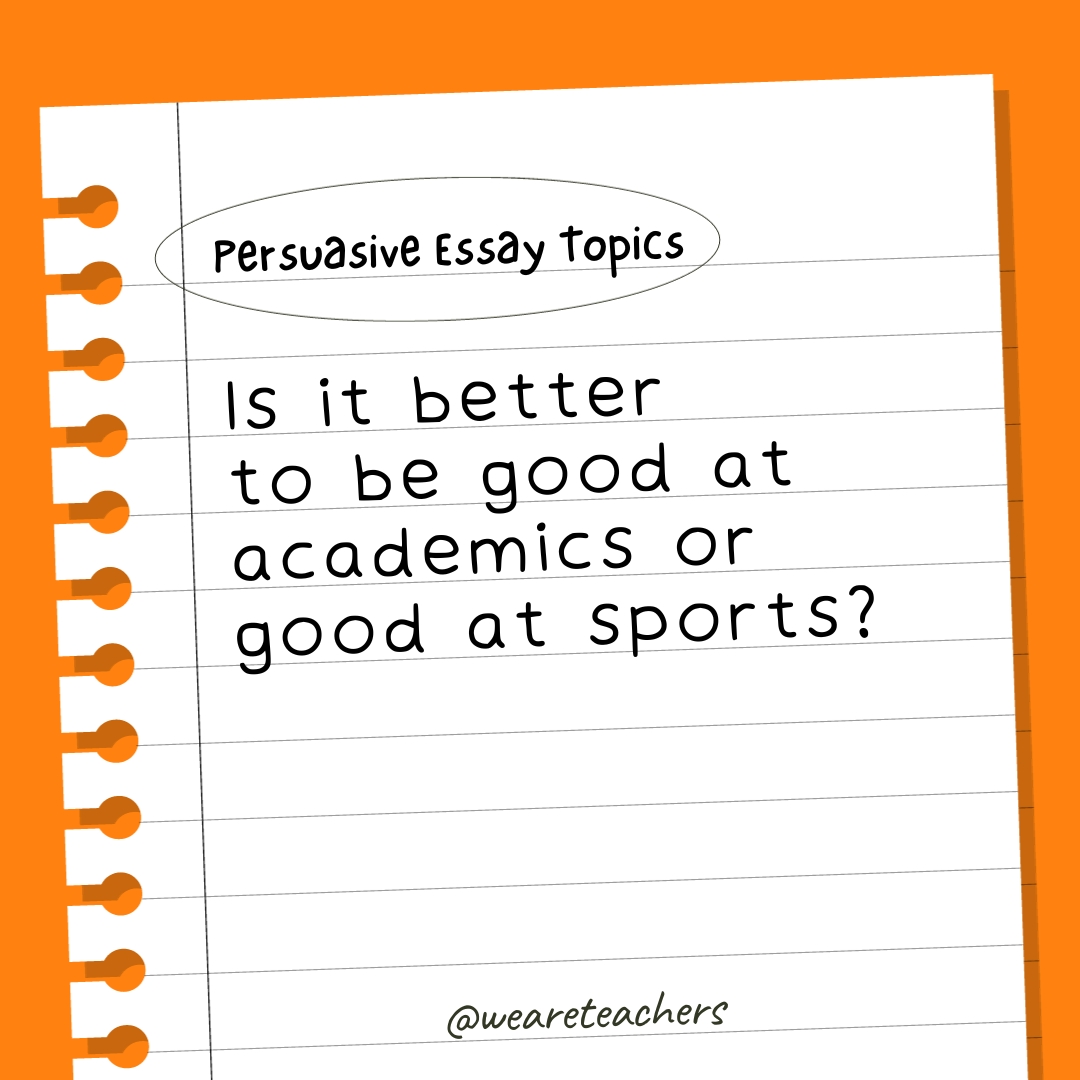
- Which is better, private schools or public schools?
- Should every student have to participate in athletics?
- Do you think schools should ban junk food from their cafeterias?
- Should students be required to volunteer in their communities?
- What is the most important school subject?
- Are letter grades helpful, or should we replace them with something else?
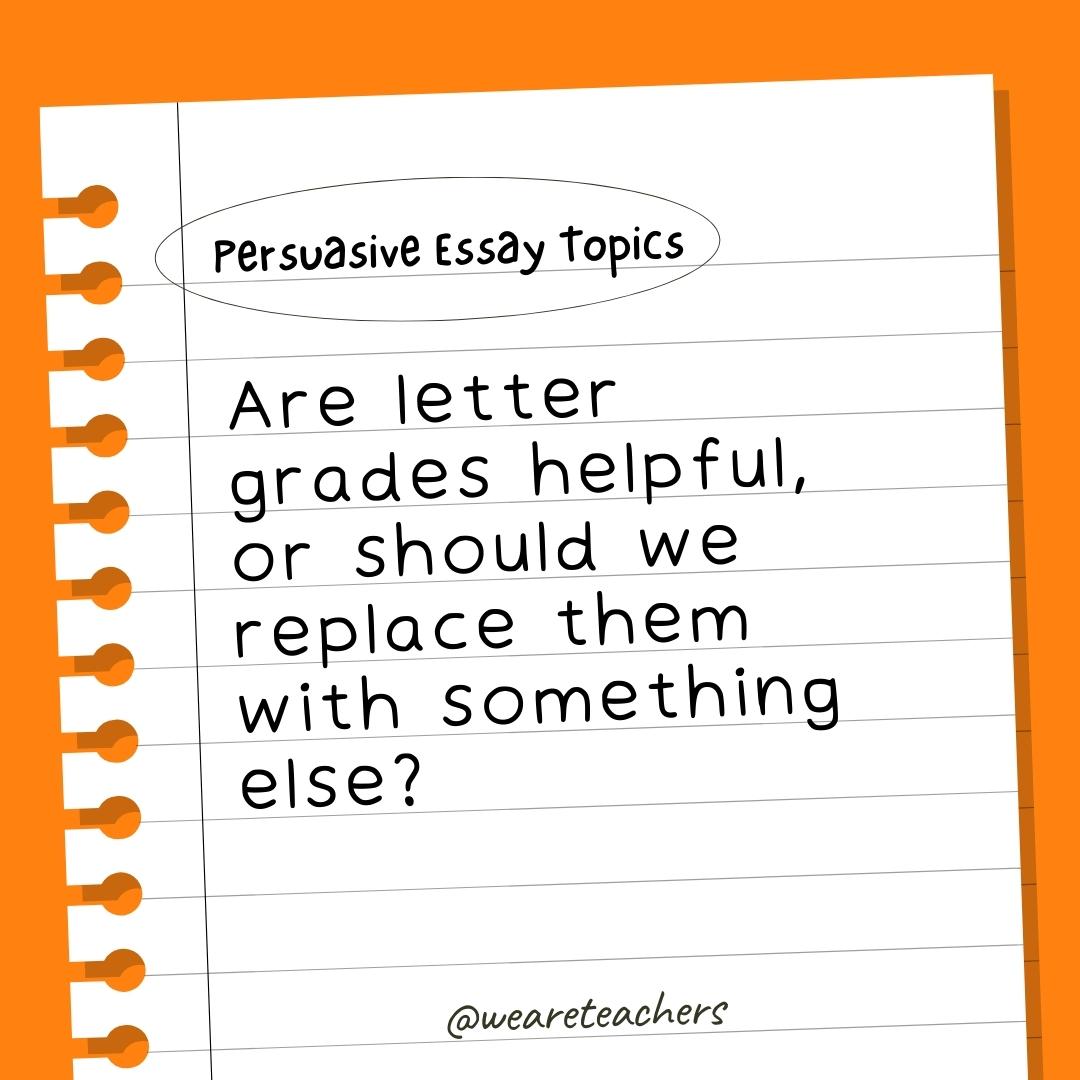
- Is it ever OK to cheat on homework or a test?
- Should students get to grade their teachers?
- Do you think college should be free for anyone who wants to attend?
- Should schools be allowed to ban some books from their libraries?
- Which is better, book smarts or street smarts?
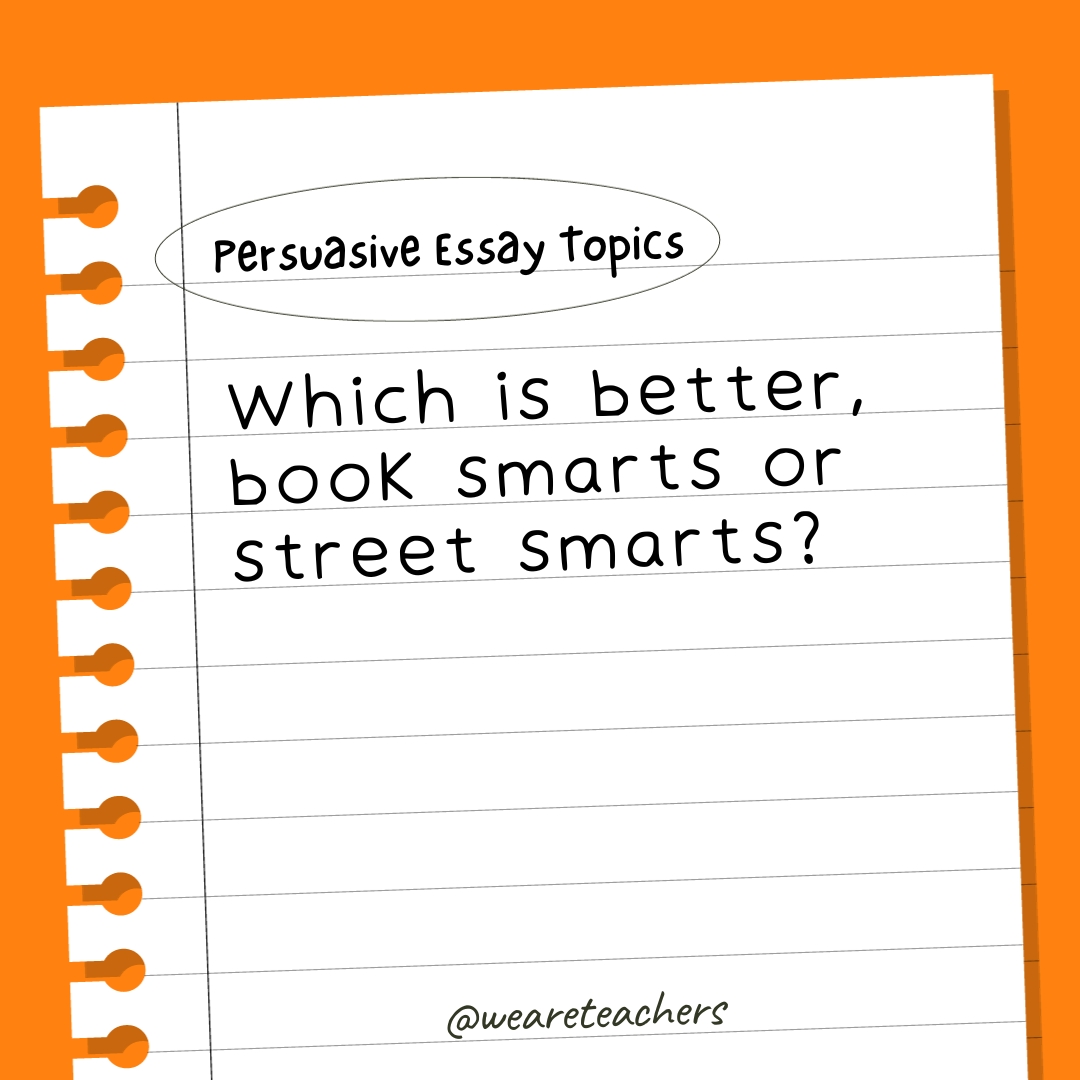
- Should all students have to learn a foreign language?
- Are single-gender schools better or worse for students?
- Is it OK to eat animals?
- What animal makes the best pet?
- Visit an animal shelter, choose an animal that needs a home, and write an essay persuading someone to adopt that animal.
- If you find money on the ground, should you try to find the person who lost it, or is it yours to keep?
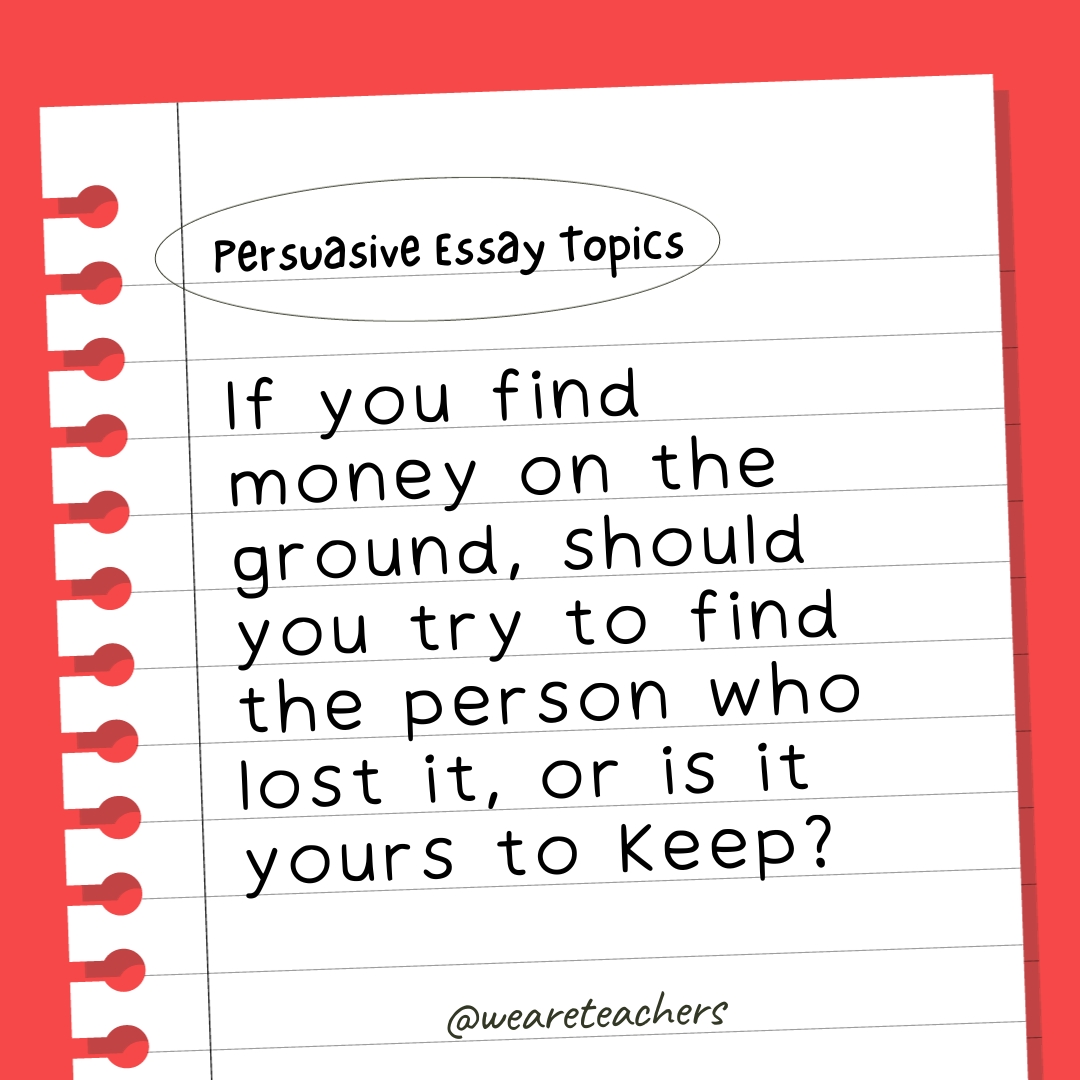
- Who faces more peer pressure, girls or boys?
- Should all Americans be required to vote?
- Is it better to be kind or truthful?
- Which is better, giving or receiving?
- Is it OK to keep animals in zoos?
- Should we change the minimum driving age in the United States?
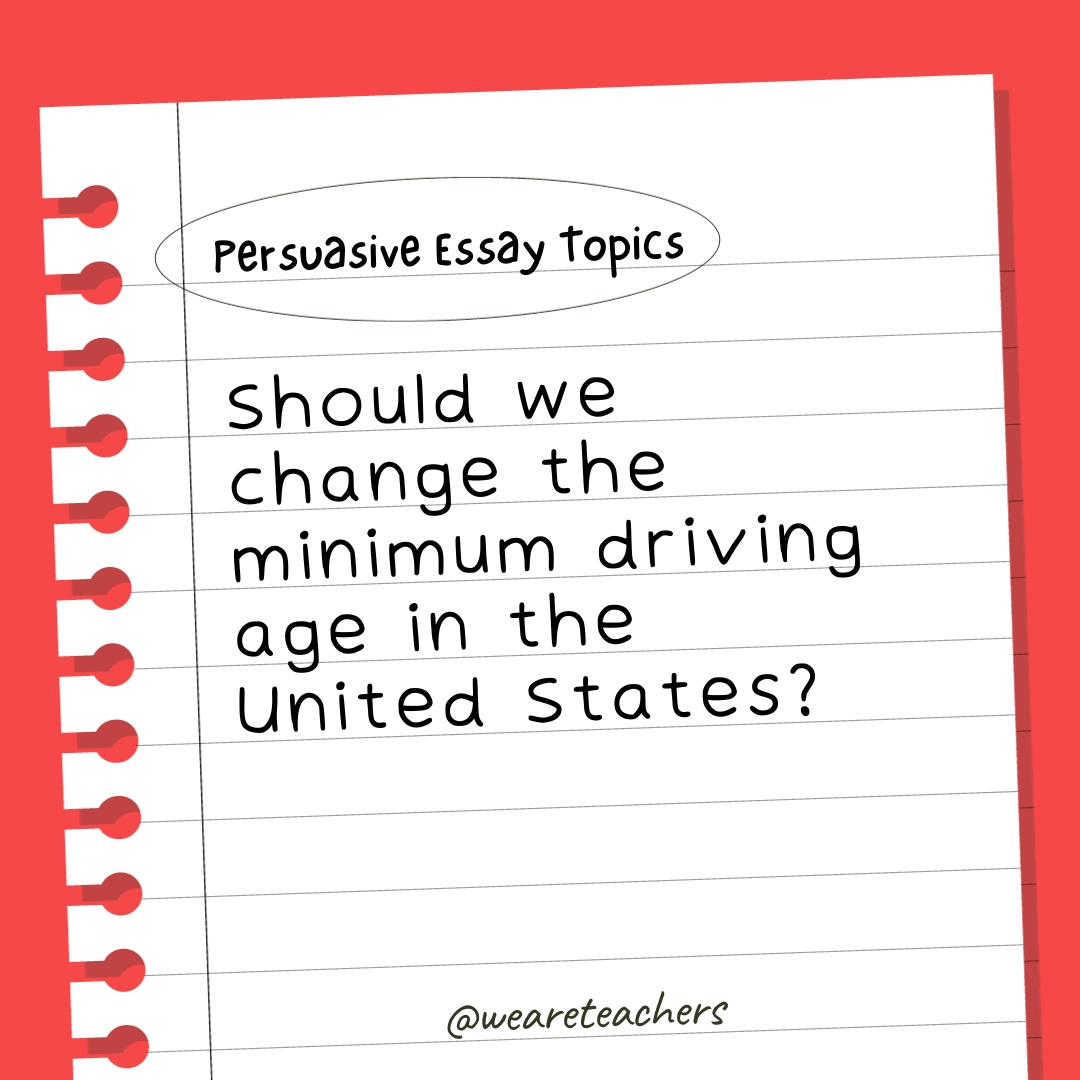
- Which is more important, happiness or success?
- Is democracy the best form of government?
- Is social media helpful or harmful?
- Should parents be punished for their children’s mistakes or crimes?
- Should kids have set bedtimes or just go to bed when they’re sleepy?
- Do you think the government should find a way to provide free health care for everyone?
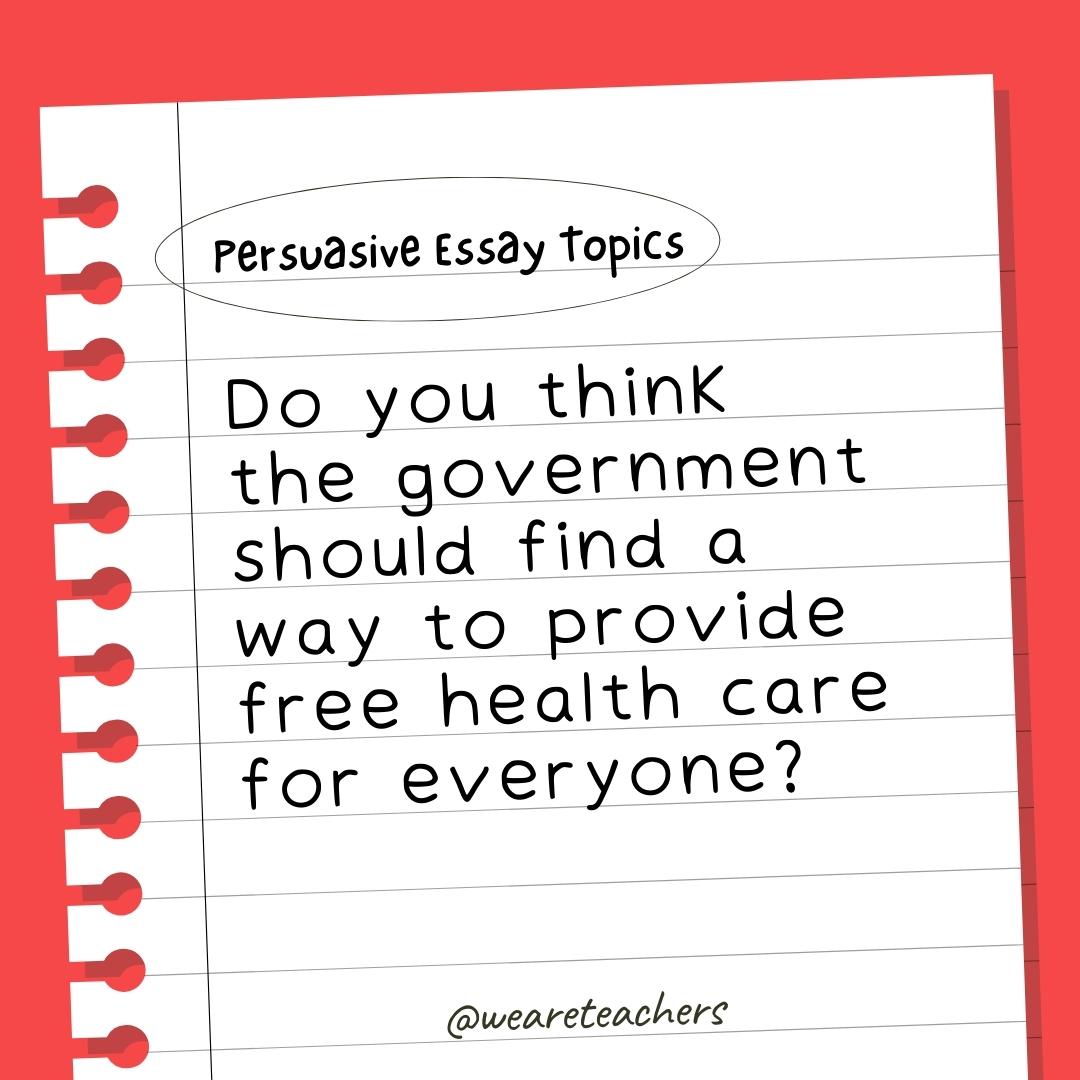
- Is it better to save your allowance or spend it?
- Should we ban plastic bags and bottles?
- Which is better, living in the city or in the country?
- If I could make a new law, it would be …
- Is Pluto a planet?
- Should human cloning be legal?
- Should vaccines be mandatory?
- Is it right for countries to still maintain nuclear weapon arsenals?
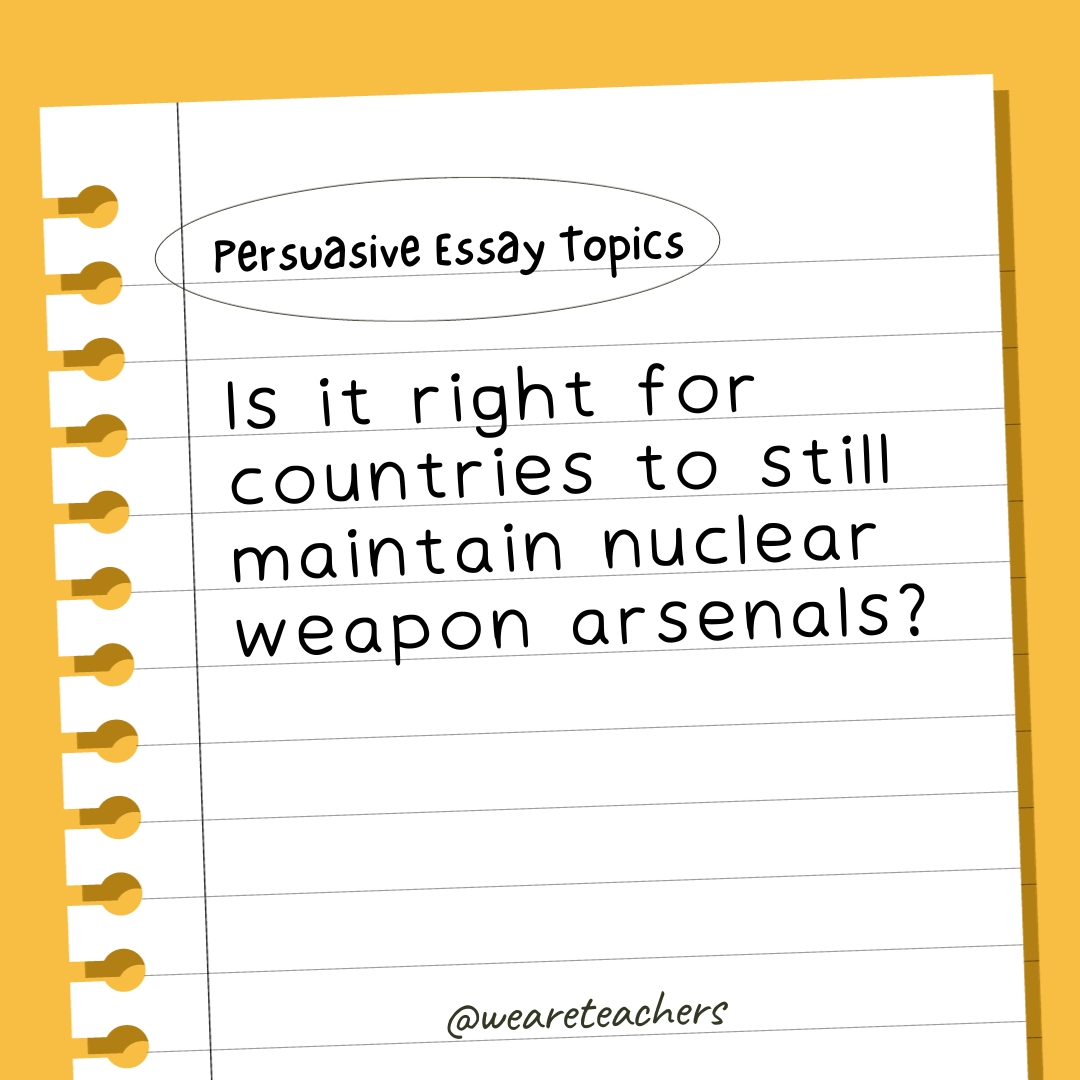
- Should testing on animals be made illegal?
- Will expanded use of artificial intelligence be good for humanity?
- Should all people have free Internet access in their homes?
- Is there intelligent life on other planets?
- Does technology create more jobs than it eliminates?
- Should parents use their children’s cell phones to track where they are?
- Should scientists try to develop a way for people to live forever?
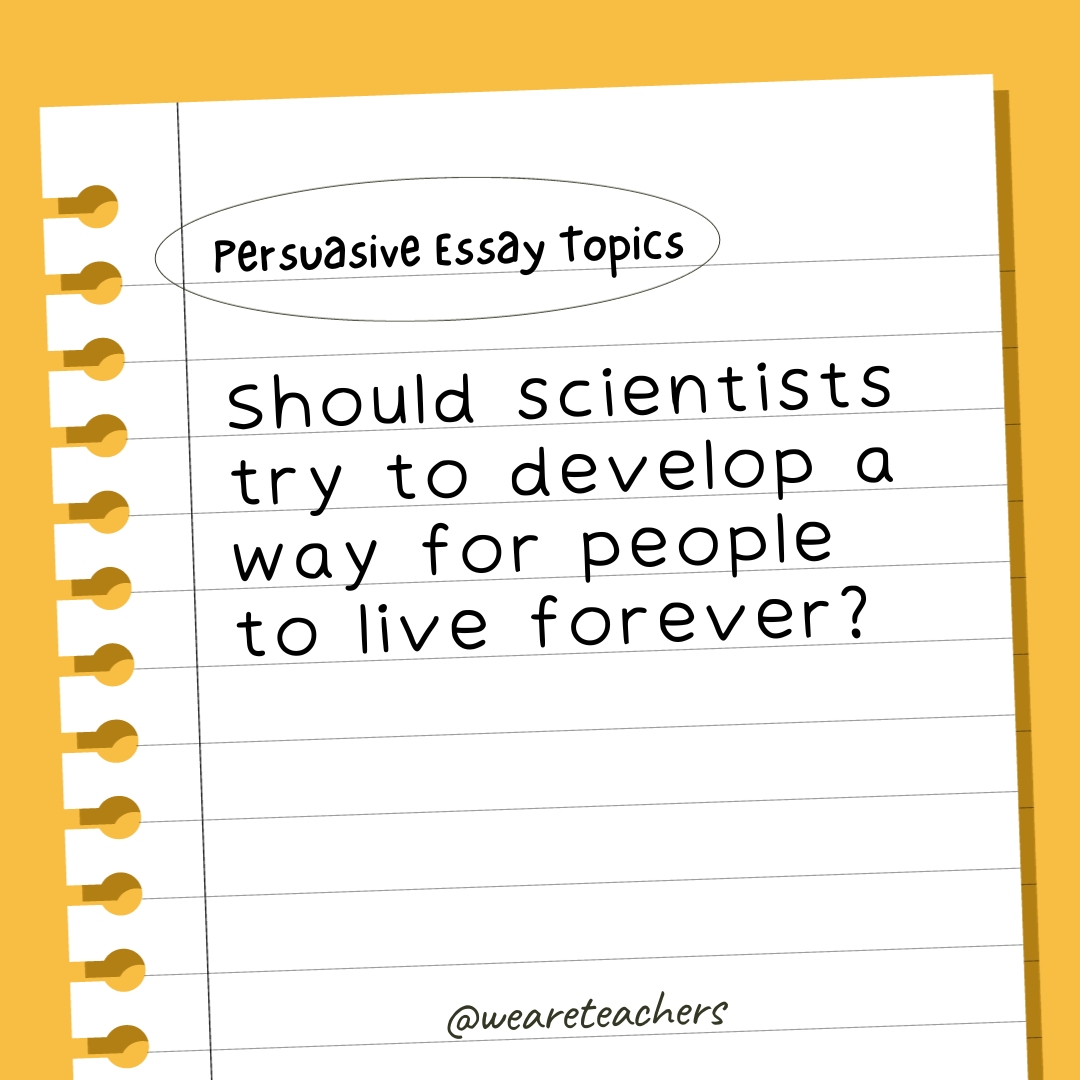
- What’s the best type of smartphone: Android or iPhone?
- Which is better, Macs or PCs?
- Do people rely too much on technology in the modern world?
- Should cryptocurrencies replace cash?
- Should there be a minimum age requirement to own a smartphone?
- Is it important to keep spending money on space exploration, or should we use the money for other things?

- Should kids under 13 be allowed to use social media sites?
- Should we ban cigarette smoking and vaping entirely?
- Is it better to be an animal that lives in the water or on land?
- Should kids be allowed to watch TV on school nights?
- Which is better, paper books or e-books?
- Is the current movie rating system (G, PG, PG-13, etc.) effective?
- Are video games better than board games?
- Should we allow little kids to play competitive sports?
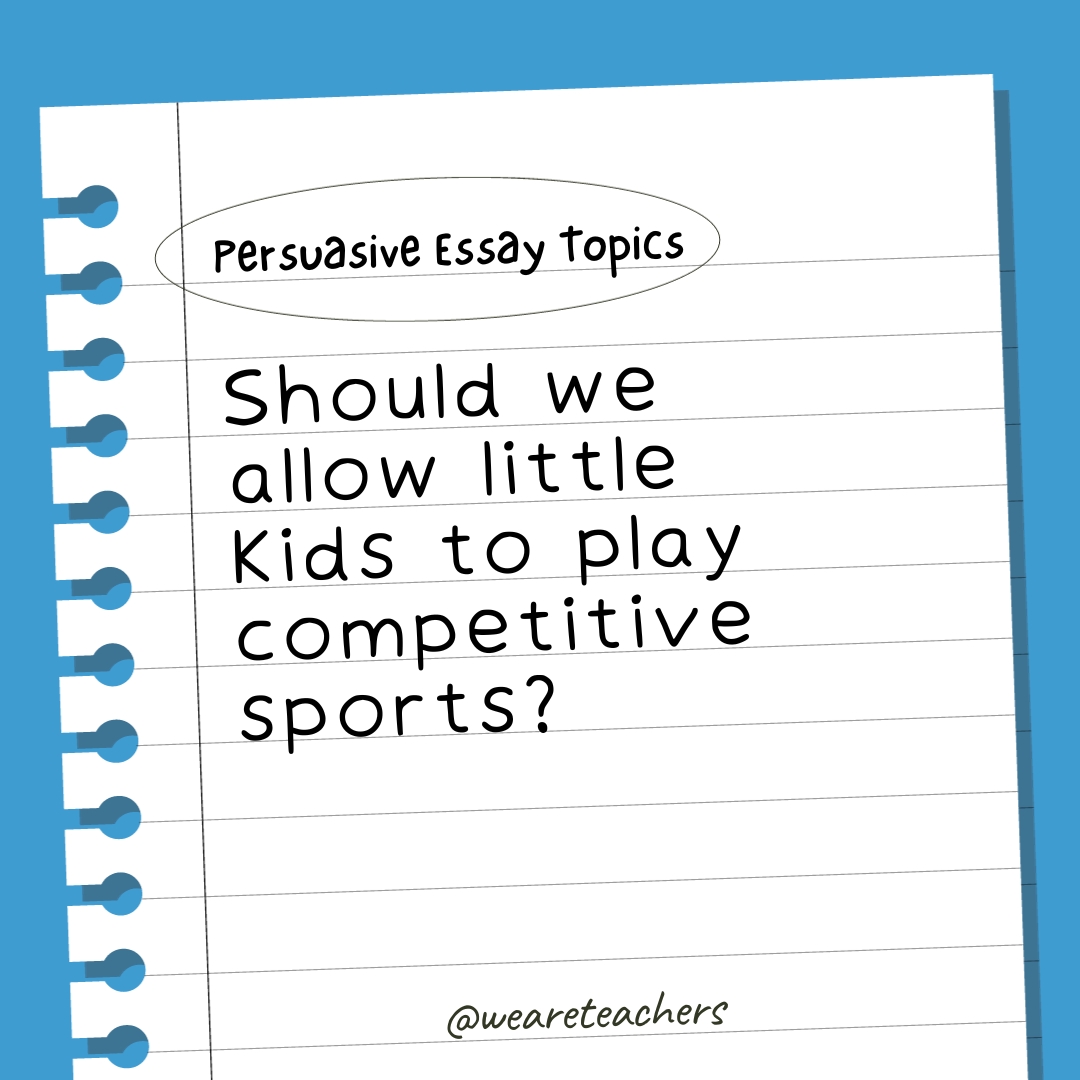
- Which is better, reading books or watching TV?
- Does playing violent video games make people more violent in real life?
- Are graphic novels just as valuable as traditional fictional books?
- Should everyone play on the same sports teams, regardless of gender?
- Choose a book that’s been made into a movie. Which was better, the movie or the book?

- Who is the world’s best athlete, present or past?
- Are professional athletes/musicians/actors overpaid?
- Which is better, fiction or nonfiction?
- The best music genre is …
- What is one book that everyone should read?
- What new sport should be added to the Olympics?
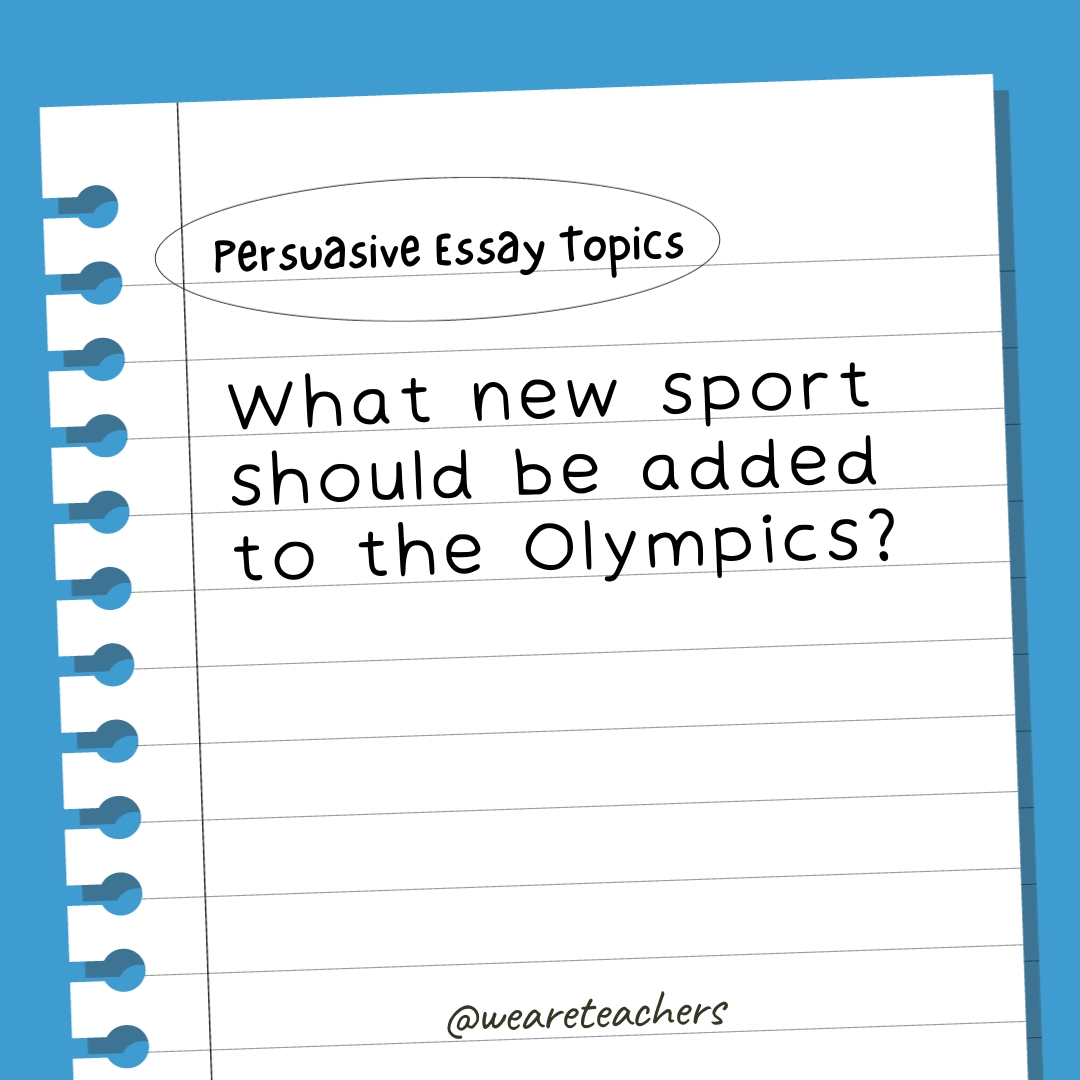
- What’s the best video game system?
- Does playing video games make you smarter?
- Does reality TV actually depict real life?
- Should all neighborhoods have free parks and playgrounds?
- What’s the best holiday?
- The very best food of all time is …
- Which is better, artificial Christmas trees or real ones?
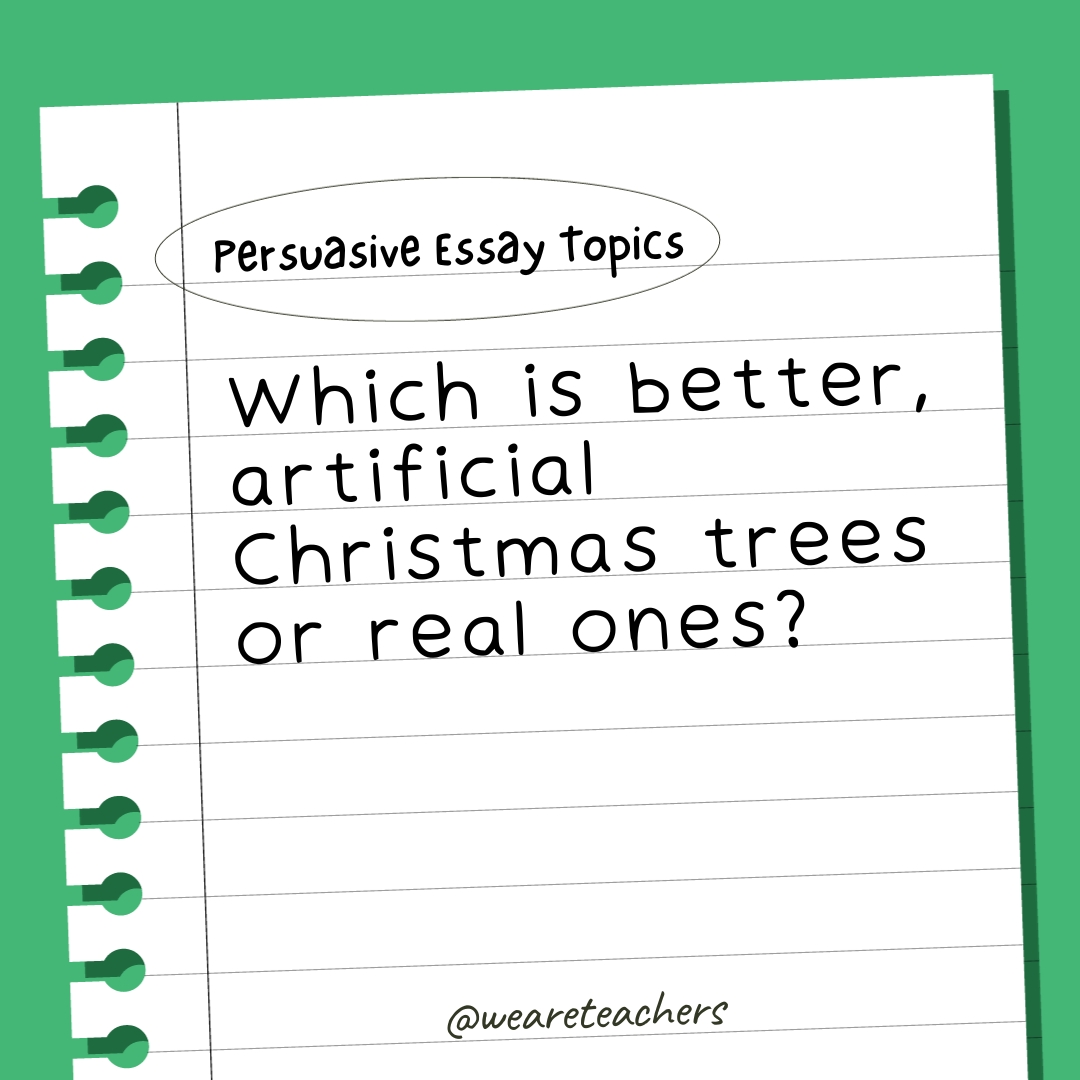
- What’s the best season of the year?
- Should you put ketchup on a hot dog?
- Is a taco a sandwich?
- Does fruit count as dessert?
- Should people have to go to school or work on their birthday?
- Are clowns scary or funny?
- Which is more dangerous, werewolves or vampires?
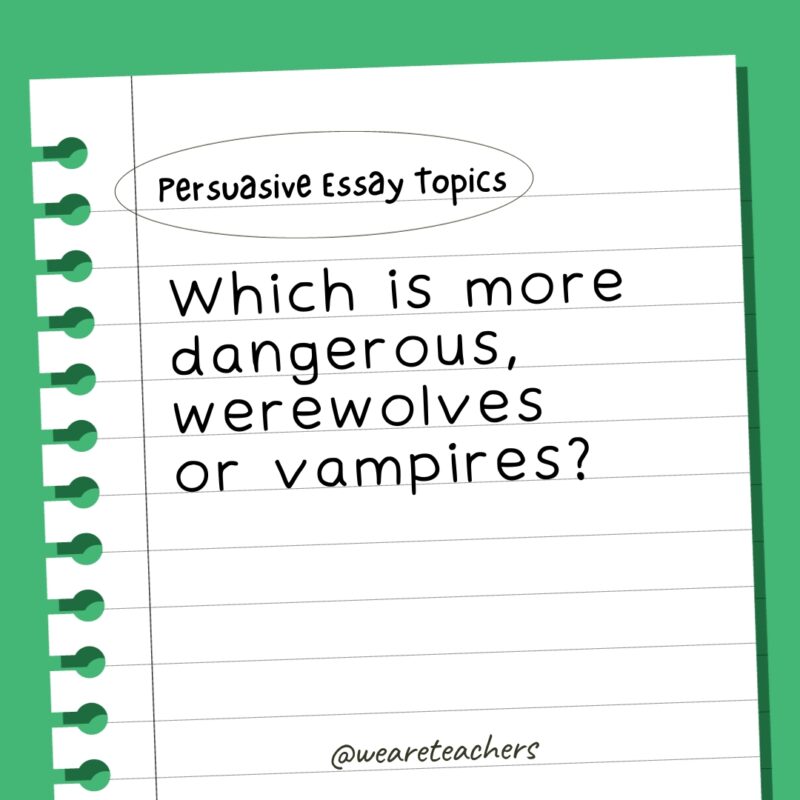
- The best pizza topping is …
- What would be the best superpower to have?
- Should everyone make their bed every day?
- Which came first, the chicken or the egg?
- Should you put pineapple on a pizza?
- Should you eat macaroni and cheese with a spoon or a fork?
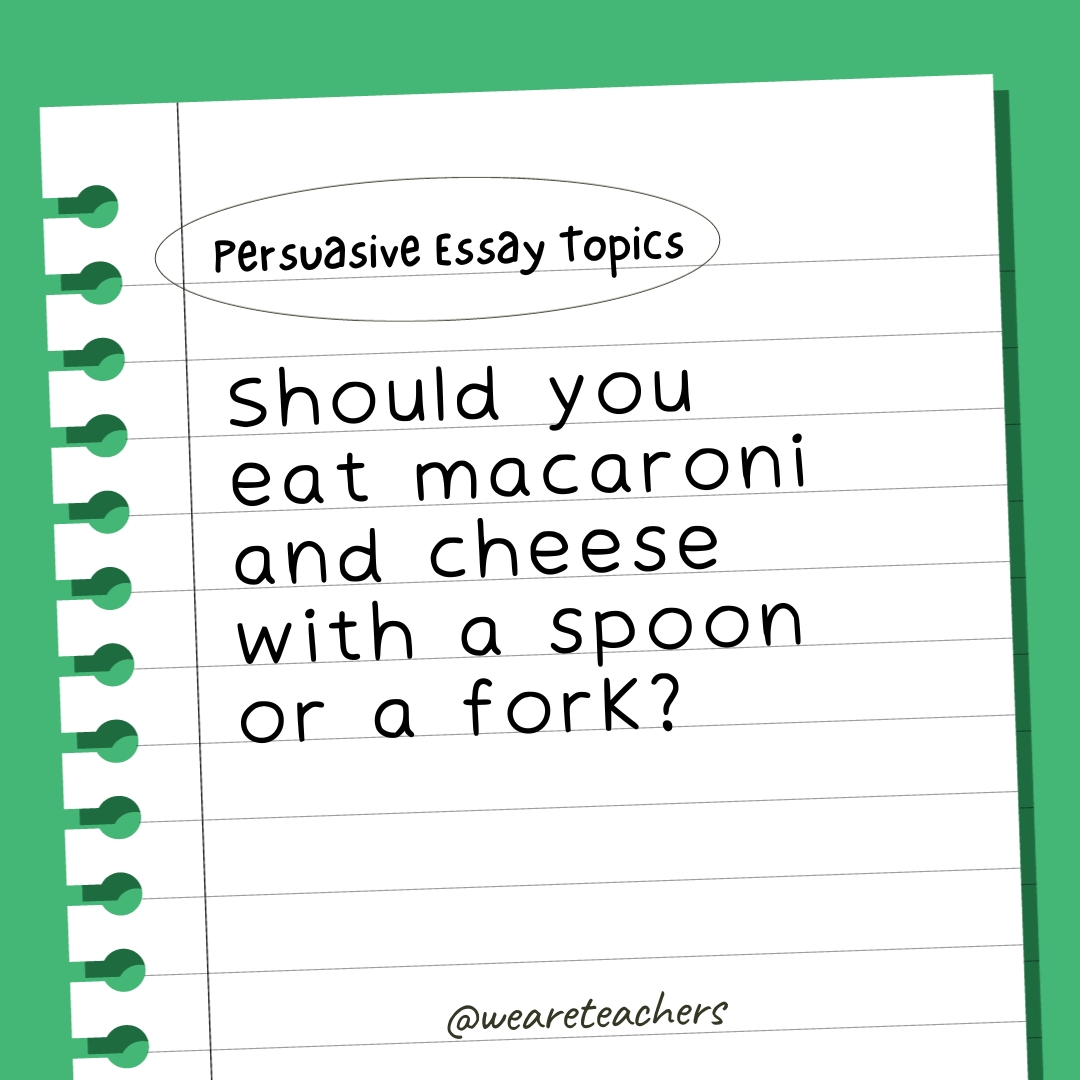
- Describe the world’s best ice cream sundae.
- Is Monday the worst day of the week?
- Would you rather travel back in time or forward in time?
- Is it better to be too hot or too cold?
- Are there aliens living among us here on Earth?
What are your favorite persuasive essay topics for students? Come exchange ideas in the We Are Teachers HELPLINE group on Facebook .
Plus, check out the big list of essay topics for high school (120+ ideas) ..
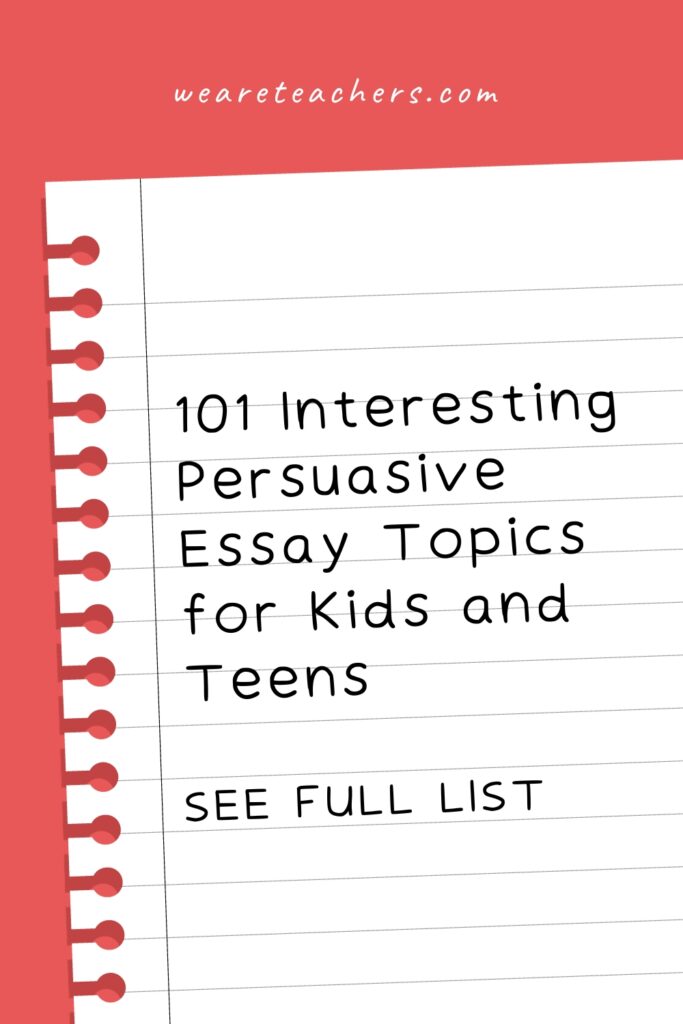
You Might Also Like

40 Strong Persuasive Writing Examples (Essays, Speeches, Ads, and More)
Learn from the experts. Continue Reading
Copyright © 2023. All rights reserved. 5335 Gate Parkway, Jacksonville, FL 32256
MAKE WAVES WITH THIS FREE WEEKLONG VOCABULARY UNIT!

10 Steps to Teach Persuasive Writing
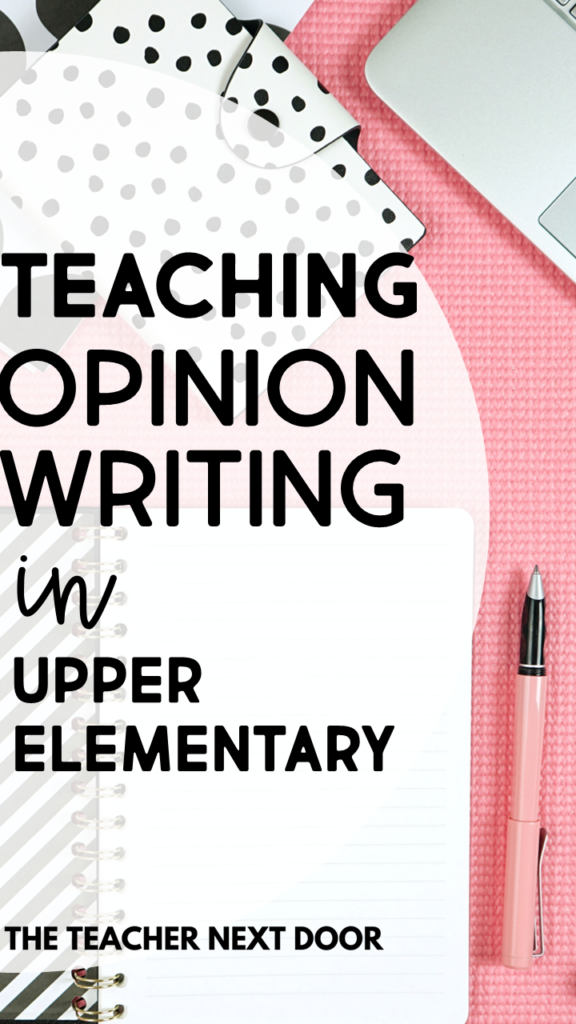
Kids are natural-born persuaders. They do it all the time. The trick as a teacher is to take their set of skills and help them use their power for good. And by good, I mean to channel these skills into writing effective persuasive pieces.
So, what exactly do we need to do to teach persuasive writing? I won’t lie to you…it’s not an easy task, but I’ll try to break it down here and simplify the steps to hopefully make this something that you can use in your classroom.
1. Teach Paragraph Writing FIRST
Before I even begin to think about teaching students to create an opinion piece, I make sure that my class has learned the basics of writing a good paragraph. We spend a lot of time with each component, and after they’ve mastered one paragraph, we move on to the five-paragraph essay.
Since I teach 4th/5th, this is one of the standards we need to reach. Once I know that students can write a reasonably good essay, then they can learn an opinion essay a little more easily.
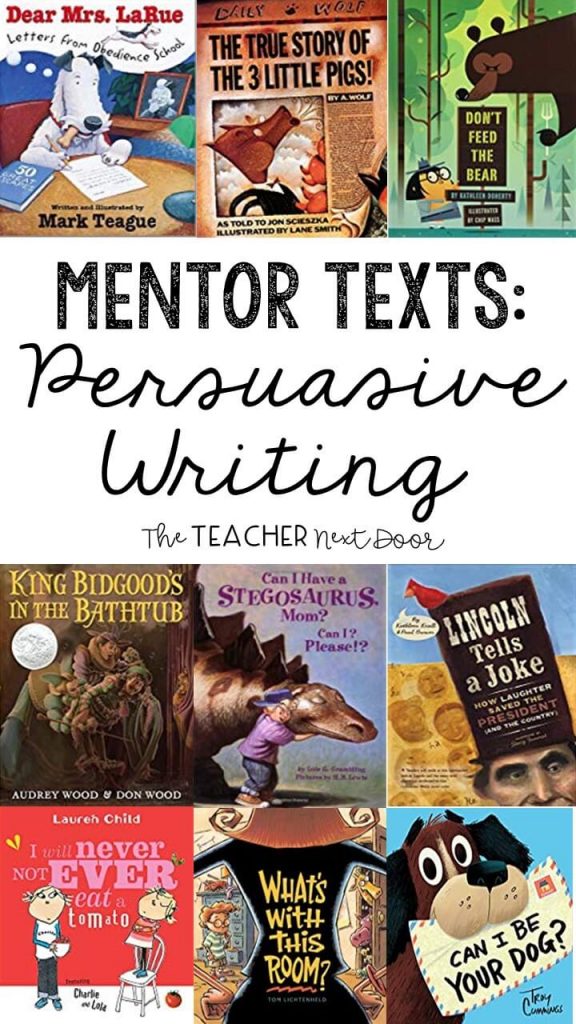
2. Use Mentor Texts to Introduce Opinion Writing
I am a big fan of mentor texts. I just love how picture books easily capture the attention of my “big” kids, while quickly teaching them so many lessons.
When I teach opinion writing, I like to gather several of these persuasive mentor texts and share them with my class. We talk about how the character used persuasive techniques well, or how he/she didn’t.
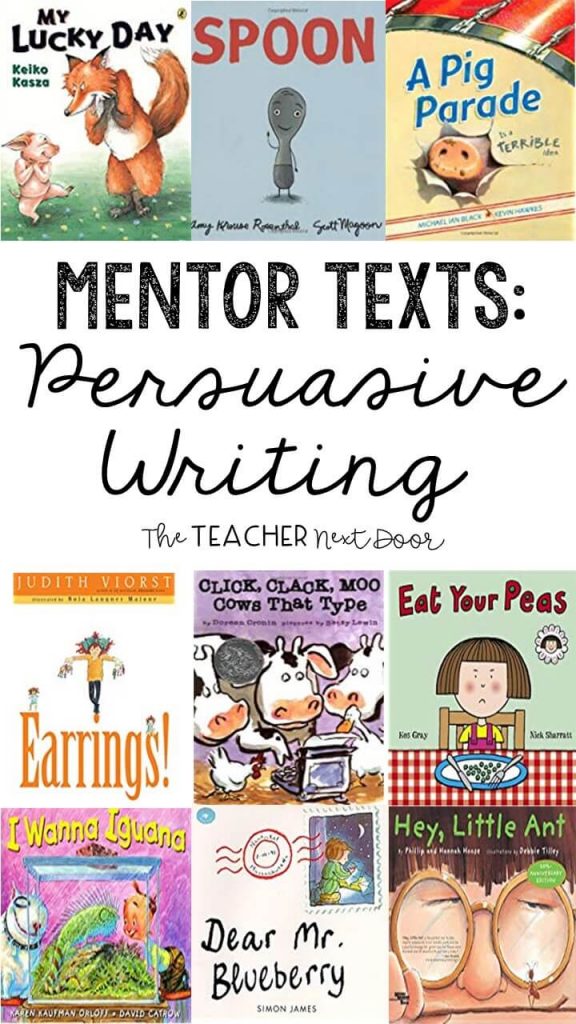
3. Start With the Big Picture
Before we start to officially write, we talk about what an opinion essay is and isn’t. I like to give students three choices with similar topics and ask them which one is the opinion essay. For example, they might choose between these titles: The Magical Elephant, Elephants and Their Families, and How to Save the Elephants. Next, I have a handout that shows the structure of an opinion essay. Since we’ve written five-paragraph essays before, they have a good handle on the basic essay structure. Then I guide them step by step through each component. We absolutely do not write a single opinion essay until we’ve had the opportunity to have lots of mini-lessons, see many examples, and practice all parts of the essay in a very low-stakes environment.
4. The Introduction Paragraph is First
A. introduce hooks.
Now we spend some time focusing on how to start the essay. We start by using a hook (also called a lead).
I like to describe a writing “hook” using a fishing analogy. The fisherman puts a nice pink, juicy worm on the hook, hoping to attract the attention of the fish. If the fish bites, the fisherman’s happy. If the fish doesn’t bite, that means that it wasn’t interested in the hook, and there won’t be any fish caught.
Our goal as a writer is to get the reader interested by “hooking” them into reading our essay, from the very first sentence.
We go over six different types of hooks and practice these. I also love using opinion writing posters as I introduce each new opinion essay concept. They’re a great reference for students on the wall or printed in miniature for writing notebooks.

B. Review Topic Sentences
For an opinion essay, the topic sentence is the opinion sentence. It is the author’s viewpoint. We do a lesson reviewing the five types of topic sentences we use for paragraph and essay writing, and I show students how to tweak these into opinion statements.
C. Time to Add the Three Reasons
The last part of the introduction lists the three reasons for our opinion. I teach students that these can be listed as a single sentence with commas between them, or we can write three separate sentences, one for each reason.
For the first lesson on reasons, I give students a topic (cell phones or vending machines at school or which season is the best, etc.) and then ask students to write three bullet points on their whiteboards. Next to each one, they write a word to describe a reason they like/dislike this idea.
For example, if the topic was school uniforms, the child might write lack of individuality, gets boring, uncomfortable… I can quickly glance at their lists while we discuss a few of them, and then we’re ready to practice with the next topic.
Without writing a whole essay, this is teaching students to think about organization and how reasons help support their opinions. I think this kind of practice is great!
When we transition this activity to a full essay, these reasons would turn into the topic sentences for each body paragraph of a five-paragraph opinion essay!
Btw.. if you don’t have whiteboards for your class, this is something you’ll really want to consider. They’re great for writing practice and so many things. I actually purchased shower boards at Home Depot for about $15 to make into whiteboards. They cut them into 12 x 12-inch squares for me for free!
5. Review, Review, Review
After we spend some time on each main section of the opinion essay (the introduction, the body paragraphs, and the conclusion), I like to give my students activities to really reinforce what they’ve learned. Besides review worksheets, we do games (like Stump the Expert), sorts, and color coding.
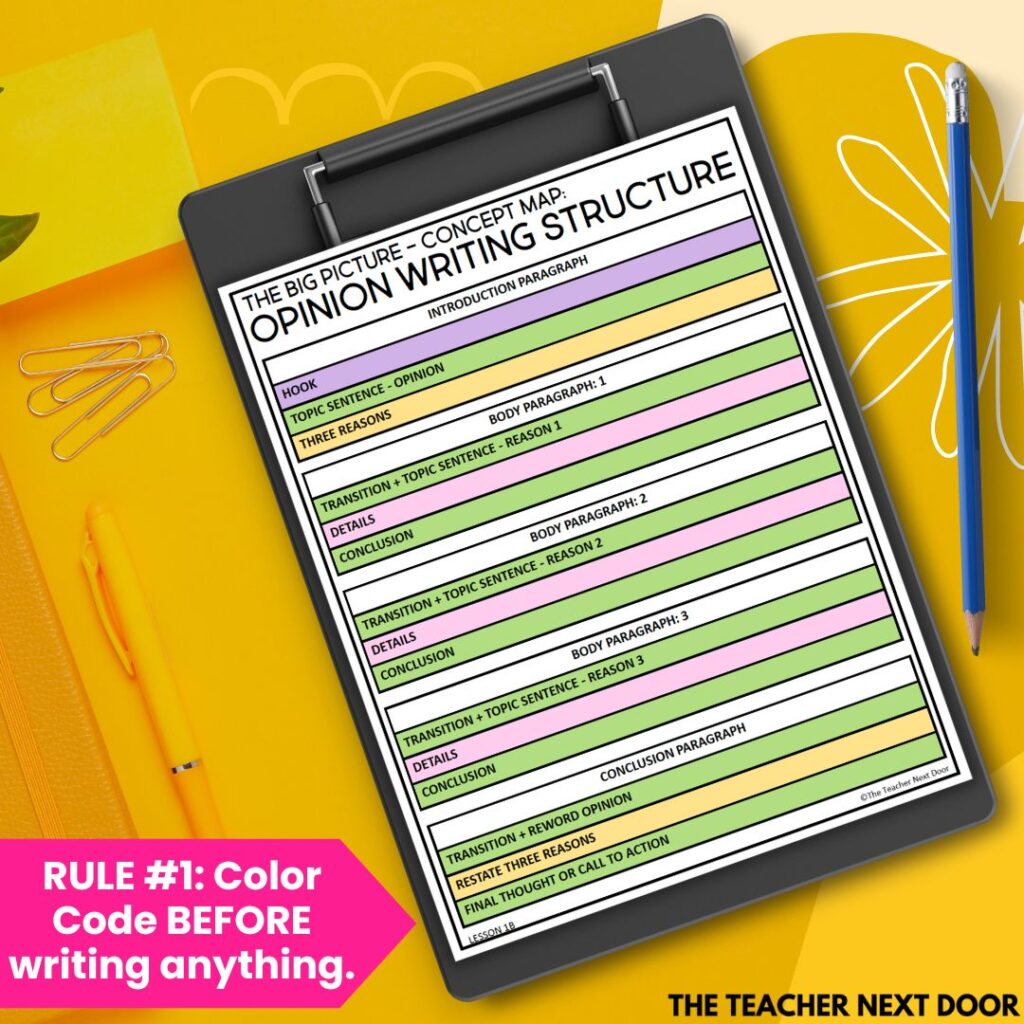
I really like to have students color code already-made paragraphs so they can see examples of quality writing, and they can master the structure of the paragraph . Once we’ve reviewed the introduction, it’s time to move on to the body paragraphs.
6. The Three Body Paragraphs are Next
There are three parts of each body paragraph, and I teach each part separately, one by one. The parts include a topic sentence that starts with a transition, three to five details to describe and explain the author’s reason for his/her viewpoint, and a conclusion sentence.
These three paragraphs are the meat of the essay. This is where students explain why they support or don’t support something.
We spend time doing activities like looking at three sentences and identifying which one is the topic sentence, which one is a detail, and which one is a conclusion sentence.
We look at pre-made topic sentences and related conclusion sentences and rate them as part of a great class discussion and then in pairs or independently. Then, we review with more color coding, games, and sorts.
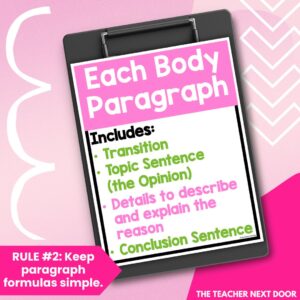
7. Focus on the Conclusion Paragraph
Conclusions can be a little intimidating for some students. Maybe it’s because they’re tired from the heavy lifting of the other four paragraphs, but with practice, you can help take away some of their apprehension and replace it with confidence!
The conclusion paragraph is a shorter paragraph (in 3rd – 5th grade) than a body paragraph. It has three distinct parts, an opinion sentence that starts with a transition, the three reasons, and a final thought or call to action.
A. The Opinion Sentence Starting with a Transition
The opinion sentence is really a topic sentence. It reinforces the same idea presented in the introduction paragraph but uses synonyms and usually a different type of topic sentence than the introduction to add variety.
We go over specific transitions that can be used for conclusions. While students may not always use a transition for their conclusion later on, I think it gives students structure and helps them break the ice of crafting a strong conclusion paragraph.
B. The Three Reasons (again!)
Just like the introduction paragraph, the conclusion paragraph lists the three reasons, usually in a single sentence with commas. Like always, you’ll want students to reword the sentence using synonyms to add variety.
C. The Conclusion, The Ending, The VERY LAST SENTENCE!
This last sentence is another place students may feel apprehensive to write at first. We go over the difference between a final thought and a call to action and practice by seeing lots of exemplars and then creating our own.
By the time we’re finished, most students understand how to gracefully and effectively add the conclusion sentence to finish the opinion essay.
Just like we usually do, once we finish a section, we review that section carefully using handouts, sorts, color coding, games, and reviews.
8. Share an Opinion Essay Example
It’s one thing to talk about an opinion essay’s components and to even practice them. It’s another thing to see a really good example of an essay and to get to go through it and discuss what makes it work and why.
I have several great examples I’ve saved over the years (and I have two that I wrote and included in my opinion essay unit). We take time to color code the essay and then create a reverse outline for it. They save this essay as an example.
9. Make an Outline and an Essay as a Whole Class (Eeek!)
Okay, here’s where your perseverance has to kick in.
Trying to complete an essay as a whole class will drive even the most saintly of teachers to want to pull their hair out at times, but this hard part is crucial. There, I said it. It is that important that this is a step you shouldn’t miss.
Here’s how I do it. I break it down into two to four days. On the first day, we created an outline together. I have students write this outline in their Writer’s Notebooks as a model to refer to when they need to make their own outline later.
We always do school uniforms, because I find it to be a great topic and one that my students feel strongly about.

I tell them for the sake of continuity, we need to take a stand as a class for the essay, whether they really agree with that stand or not. We take a class vote and then stick with it, whether it’s for or against the uniform idea.
On the second day, when we have the outline in place, I make a deal with the kids…I tell them if they stick with me, stay on task, and participate…I’ll do the writing (this time), and they can just tell me what to write.
If they don’t stay focused, then they’ll have to write it themselves. This works like magic. I’ve never had a class that lost out on this “deal.”
So, using yesterday’s outline, we go step by step and write each paragraph together. Students feed me sentences (I write these on the SmartBoard), which I try to use or gently guide them a bit where needed.
Usually, we do about 2 paragraphs in one day. The attention spans of 8 – 11-year-olds can be a killer, so I find that breaking it into several days helps.
10. Before Students Write – Go over Expectations Using a Rubric
I really like to use rubrics for lots of assignments. It breaks down the activity into its components, and it also serves as a road map for students to know what is expected of them. I think the more we can explain to students exactly what we’re looking for, the more they can meet and sometimes exceed (hallelujah) our expectations.
There’s never a reason to hide what we want from students, in my opinion. So, we go over the rubric together, and it’s a kind of review for all the lessons leading up to this. You can three-hole punch it so they can store it in their binders, or you can print it in a smaller size to fit their Writer’s Notebooks if you wish.
BONUS #11. Practice Writing Opinion Essays…Over and Over and…
Once your students have practiced each part of the opinion essay and are very familiar with its structure, it’s their turn to write independently. I choose several different topics for them over the next few weeks, and we do about an essay a week in class. The students get better as time goes by, and usually, I let them choose a topic for the last essay or two. It’s interesting to see what they come up with.
Whew…such a huge unit and so many skills to fit in, but in my mind, it is an awesome unit. I love teaching it because of the great number of discussions it provides and because I see it as an important set of tools for them to have in their writing toolboxes.

If you’d like some resources for opinion writing , I love this unit I created. It’s a bundle with over 100 printable pages and includes a digital format too. It will take you through the entire process with teaching pages, and detailed teaching notes, student practice pages, activities, and posters for 3rd – 5th grade.
Sarah is a 4th Grade Teacher and uses this unit and process in her classroom. This is what she had to say.

CLICK HERE TO FIND THE OPINION WRITING BUNDLE ON TPT!

- Read more about: Writing & Grammar
You might also like...

Unlocking Student Writing Success: The Power of Explicit Writing Instruction
As upper elementary teachers, our goal is to create strong writers. However, the lack of Explicit Writing Instruction has caused students in the US to
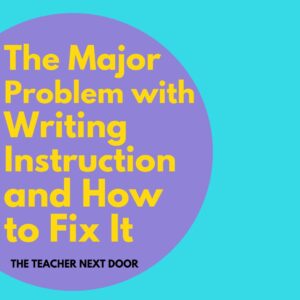
The Major Problem with Writing Instruction and How to Fix It
Writing instruction at the elementary level needs an overhaul. The last time the National Assessment of Education Progress (NAEP) measured 8th-grade students’ writing proficiency in
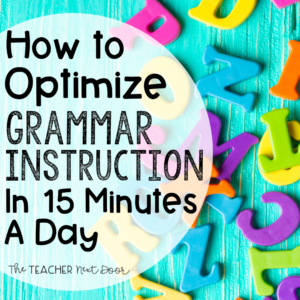
How to Optimize Grammar Instruction in 15 Minutes a Day
As elementary school teachers, we are always thinking about how to integrate subjects. History content and nonfiction text features. A science equation and a math
Hi, I’m Jenn, CEO and owner of The Teacher Next Door!
I know that you strive to be an effective upper elementary teacher while maintaining a healthy work-life balance.
In order to do that, you need resources that are impactful, yet simple .
The problem is that most resources and curriculums out there are far from simple. The pages upon pages of daily lesson plans are just plain overwhelming .
At TTND, we believe teachers should be living their lives outside of the classroom, and not spend hours lesson planning and searching for resources.
We understand that now, more than ever, teachers need space to be themselves which is why we create and support teachers with timesaving tips and standards-aligned resources.
Want access to TTND's Free Resource Library? Sign up for our newsletter and we'll email you the exclusive password!
Trending posts.

SEARCH BY TOPIC
- Classroom Ideas
- Holidays and Seasonal
- Mentor Texts
- Reading Block
- Uncategorized
- Writing & Grammar
POPULAR RESOURCES

Facebook Group
Teachers Pay Teachers
Free Resource Library
💌 Contact Us
Disclosures
Privacy Policy
Refund Policy
Purchase Orders
Your Downloads
Reward Points
© The Teacher Next Door, LLC. All rights reserved.

* Please note: If your school has strong email filters, you may wish to use your personal email to ensure access.
Save 10% today on your lessons using the code GIVEME10

Middle School Persuasive Writing Lessons

Finding engaging and rigorous persuasive writing lessons should not be a challenge to find. Unfortunately, not all writing curriculums and activities draw the attention of our students and encourage their engagement. Consequently, the lessons they learn in these classes are not as solid or memorable as they could be.
From the time we are old enough to talk, persuasion is a skill that we use on a regular basis. As we get older, the stakes become much higher than a simple “Let me have an extra cookie after dinner tonight, please.” From the everyday discussions with a partner about where to go on vacation to the much more significant ones like convincing a boss to give you a raise, persuasion is a part of all of our lives and a skill that has a tangible and significant impact.
Making sure our students have a solid foundation in persuasion and these persuasive writing lessons will help set them up for success in the future.
Let’s look at three persuasive writing lessons that offer solid instruction while also being particularly engaging to your students.
Persuasive Writing Lessons

Persuasive Pitch Assignment
If your students like the TV show Shark Tank or Dragon’s Den , they will love this assignment. In it, students develop an idea of how to improve their school (e.g., installing recycling bins, creating a snack program, etc.), and then they pitch their idea to the judges (their classmates).
After watching all the presentations, students will vote on which idea they like best. This assignment is scaffolded into five different lessons. The familiar format, as well as the element of competition, encourages students to do their best and helps drive home the curricular lessons on persuasion.
Find the Persuasive Pitch Assignment on Shopify CAD or Teachers Pay Teachers USD .
Teacher Feedback
“My students loved the idea of Dragon’s Den style product pitches to learn persuasive techniques! They had a blast while watching the two show episodes and analyzing the products, as well as creating their own products and pitching them. They created excellent advertisements and came up with great ideas!”

Persuasive Writing – Michael vs. LeBron
Oftentimes the problem with persuasive writing lessons is that students don’t really care (or care much) about the topic about which they are writing. This is not the case with this lesson. In it, students practise gathering evidence from a podcast (an oral text) and use that evidence to support their writing.
After listening to the evidence presented by the podcast, students must decide who is the greatest basketball player of all time – LeBron James or Michael Jordan. By grabbing your students’ attention with a topic they are interested in and one that may be rather unexpected in the language arts classroom, you help students be excited and want to learn more about effective persuasive writing.
Find the Michael vs. LeBron Persuasive Writing lesson on Shopify CAD or Teachers Pay Teachers USD .
“Loved this persuasive writing unit so much! I have quite a few basketball fans in the class and so it was quite the hit. Thanks!”

Rant Writing Unit
Rant writing is an engaging way to bring public speaking and persuasive writing into the classroom. Students rant and complain to each other daily – why not channel that creative energy into some high-quality writing? By utilizing things that students are already engaged with and encouraging students to share their thoughts and opinions, this unit is an effective way to teach persuasive writing.
Whether you choose to use these lessons or something else, the importance of a solid foundation in persuasion cannot be overstated. Helping students remember the lessons they learn in your class going forward and throughout their lives sets them up for future success.
You can grab this Rant Writing Unit for free here .
“My communications class absolutely loved this activity and even asked at the end to do it again!! It was very engaging.”
Additional Resources
- Middle School Writing Lessons
- Creative Writing Lesson Plans
Related Posts

This FREE persuasive writing unit is
- Perfect for engaging students in public speaking and persuasive writing
- Time and energy saving
- Ideal for in-person or online learning
By using highly-engaging rants, your students won’t even realize you’ve channeled their daily rants and complaints into high-quality, writing!


65+ Persuasive Essay Topics for Middle School Students
Middle school students can improve their writing and critical thinking skills by writing persuasive essays. This list of persuasive essay topics will help them choose a topic that they are passionate about and that will help them make a strong argument.
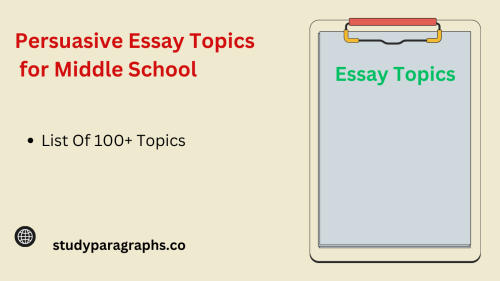
Table of Contents
List of Persuasive Essay Topics for Middle School Students
- Should students be allowed to have cell phones in school?
- Should schools require students to wear uniforms?
- Should students be allowed to choose their own classes?
- Should schools have a longer summer break?
- Should schools offer more extracurricular activities?
- Should schools have a later start time?
- Should students be required to take physical education classes?
- Should schools ban junk food?
- Should schools teach students about financial literacy?
- Should schools offer more vocational training programs?
- Should students be allowed to use calculators during math class?
- Should schools have mandatory drug testing?
- Should schools offer more mental health resources?
- Should schools have a mandatory community service requirement?
- Should students be required to take a foreign language ?
- Should schools ban single-use plastics?
- Should schools teach students about climate change ?
- Should students be allowed to have pets in school?
- Should schools offer more field trips?
- Should students be required to wear helmets while riding bikes?
- Should schools offer more technology classes?
- Should schools have a dress code?
- Should students be allowed to use social media during school hours?
- Should schools have a longer school day?
- Should students be required to take a life skills class?
- Should schools have more security measures?
- Should schools teach students about healthy eating habits?
- Should students be allowed to have a part-time job while in school?
- Should schools have more art programs?
- Should schools have more music programs?
- Should schools have a later end time?
- Should schools have more foreign exchange programs?
- Should schools have more community service opportunities?
- Should schools have more recycling programs?
- Should schools have more renewable energy sources?
- Should schools have more vegetarian and vegan options in the cafeteria?
- Should schools have more sports teams?
- Should schools have a mandatory home economics class?
- Should schools teach students about mental health?
- Should schools have more dance programs?
- Should students be required to take a public speaking class?
- Should schools have more drama programs?
- Should schools have more debate teams?
- Should schools have more writing clubs?
- Should schools have more science fairs?
- Should schools have more math clubs?
- Should schools have more book clubs?
- Should schools have more community service clubs?
- Should schools have more cooking classes?
- Should schools have more robotics classes?
- Should students be required to take a financial literacy class?
- Should schools have more field day events?
- Should schools have more gardening programs?
- Why should schools have dress codes?
- Should school buses have seat belts?
- Should middle school students be allowed to carry cell phones?
- Why is breakfast important and should schools provide free breakfast for all students?
- Should students have to wear uniforms to school?
- Should physical education be mandatory in middle school?
- Why is sleep important and should middle school students have later start times?
- Should schools ban junk food and provide healthier lunch options?
- Why is art education important and should it be mandatory in middle school?
- Should middle school students be allowed to have jobs?
- Should schools have therapy dogs to help students with stress and anxiety?
- Why is it important to learn a second language and should it be mandatory in middle school?
- Should schools have stricter policies on bullying?
- Why is it important to have diverse literature in schools?
- Should schools have gender-neutral bathrooms?
- Should middle school students be allowed to use social media in school?
- Why is it important to have music education in schools?
Middle school can be a challenging time for students as they navigate new social and academic responsibilities. Writing persuasive essays can help students develop critical thinking skills and learn how to effectively communicate their opinions and ideas. By selecting a persuasive essay topic that is relevant and engaging, middle school students can not only improve their writing abilities, but also explore important issues and develop a better understanding of the world around them. These persuasive essay topics for middle school students offer a range of options for students to choose from and spark their creativity and critical thinking.

Hello! Welcome to my Blog StudyParagraphs.co. My name is Angelina. I am a college professor. I love reading writing for kids students. This blog is full with valuable knowledge for all class students. Thank you for reading my articles.
Related Posts:
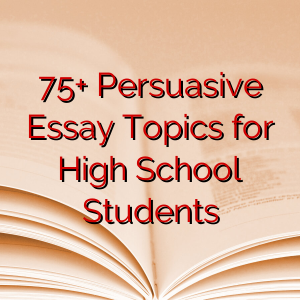
Leave a Reply Cancel reply
Your email address will not be published. Required fields are marked *
Save my name, email, and website in this browser for the next time I comment.

- About Michelle Waters
- Curriculum Vitae
- Tools I Use
- Podcast Episodes
- How To Be Our Podcast Guest
- Member Login
- Member Helpdesk
- Support Portal
- Resource Partners
- Writing Partners
- Certificate Verification
- How To Contribute
by Michelle Boyd Waters, M.Ed.
A Plethora Of Writing Examples For Middle School (& High School)
October 14, 2014 in Pedagogy

When I started my first job as a professional newspaper reporter (This job also served as an internship during my junior year in college — I just didn’t leave for about 6 years.), I quickly realized that all my experience, and all my years of journalism education had not been enough to help me write stories about drug busts, fatal car accidents and tornadoes. All the theoretical work I’d done, and all of the nifty little scholastic and collegiate stories I had done, did not prepare me for real world writing.
At that point, I had to find a solution quickly. After all, I had a deadline to meet, and it was only a few hours away.
One of my colleagues, who also served as a mentor, had the solution. She introduced me to the newspaper’s “morgue.” This was a room filled with filing cabinets in which we kept old — dead — stories arranged by reporter. Whenever I wasn’t’ sure how to write a story, all I had to do was check the morgue for similar stories. If I needed to write a story about a local drug bust, for example, I’d find another story on a similar incident, study its structure, and mentally create a formula in which to plugin the information I’d gathered.
Once I’d gained more experience, and had internalized the formula for that particular type of story, I felt free to branch out as the situation — and my training — warranted.
I do the same thing when I want to write a type of letter, brochure, or report that I’ve never written before.
This is what writing looks like in the real world.
Of course, if you’re a new teacher like me, there is one problem with providing mentor texts to my students: I have a dearth of middle school level writing sitting around in my file cabinets.
Fortunately, the Internet is full of sources, so I scoured the bowels of Google to find examples. I know how busy you are, so I’m sharing.
Expository writing examples for middle school
Below are several sources of expository writing samples for middle school students.
- The Write Source Expository Writing Samples
- Holt, Rinehart, Winston Expository Essay Models
Finally, here is an article in the New York Times that will help you teach your students real-world expository writing skills .
Descriptive writing examples for middle school
- Descriptive Writing Samples from Novels
- Milwaukee Public Schools Descriptive Essay Samples (p. 137)
- Holt, Rinehart, Winston Descriptive Essay Models
Narrative writing examples for middle school
- Writing Samples by Steve Peha (PDF)
- The Write Source Narrative Writing Samples
- Oregon Department of Education Scored Writing Samples (Ideas and Organization)
- Oregon Department of Education Scored Writing Samples (Sentence Fluency and Conventions)
- Oregon Department of Education Scored Writing Samples (Voice and Word Choice)
- Oregon Department of Education High School Scored Narrative and Argumentative Writing Samples
- Holt, Rinehart, Winston Narrative Essay Models
Argumentative/persuasive writing examples for middle school
- The Write Source Persuasive Writing Samples
- Holt, Rinehart, Winston Persuasive Essay Models
Reflective writing examples for middle school
- Reflective essay examples from Lake Washington Girls Middle School
If you know of any other online writing example sources, please feel free to share them in the comments below.
Related topics: Argumentative Writing , Informative Writing , Mentor Texts , Narrative Writing
About the author
Michelle Boyd Waters, M.Ed.
I am a secondary English Language Arts teacher, a University of Oklahoma student working on my doctorate in Instructional Leadership and Academic Curriculum with an concentration in English Education and co-Editor of the Oklahoma English Journal. I am constantly seeking ways to amplify students' voices and choices.
This is very, very helpful. Thank you for sharing!
As a new middle school teacher (coming from elementary) this was very helpful and encouraging.
Thank you very much for letting me know. I’m glad that I was able to help you!
Thank you! I’m glad I can help.
Your welcome
This is super helpful. Thank you!
These links are a fantastic help. Thank you!
This helped me BUNCHES! Thanks so much!
thanks so much!!!!!!!!!!!!!!!!!!!!!!!!!!!!!!!!!!!!!!!!!!!!!!!!!!!!!!!!!!!!!!!!!!!!!! XD
These links are now dead 🙁
Thank you for notifying me! I have updated the post to include new (live!) links. Some of them are geared towards high school, but I think we can still use them as exemplars of what we want our students to aim for.
Comments are closed.
How to Write a Persuasive Essay (This Convinced My Professor!)
.png)
Table of contents

Meredith Sell
You can make your essay more persuasive by getting straight to the point.
In fact, that's exactly what we did here, and that's just the first tip of this guide. Throughout this guide, we share the steps needed to prove an argument and create a persuasive essay.
This AI tool helps you improve your essay > This AI tool helps you improve your essay >

Key takeaways: - Proven process to make any argument persuasive - 5-step process to structure arguments - How to use AI to formulate and optimize your essay
Why is being persuasive so difficult?
"Write an essay that persuades the reader of your opinion on a topic of your choice."
You might be staring at an assignment description just like this 👆from your professor. Your computer is open to a blank document, the cursor blinking impatiently. Do I even have opinions?
The persuasive essay can be one of the most intimidating academic papers to write: not only do you need to identify a narrow topic and research it, but you also have to come up with a position on that topic that you can back up with research while simultaneously addressing different viewpoints.
That’s a big ask. And let’s be real: most opinion pieces in major news publications don’t fulfill these requirements.
The upside? By researching and writing your own opinion, you can learn how to better formulate not only an argument but the actual positions you decide to hold.
Here, we break down exactly how to write a persuasive essay. We’ll start by taking a step that’s key for every piece of writing—defining the terms.
What Is a Persuasive Essay?
A persuasive essay is exactly what it sounds like: an essay that persuades . Over the course of several paragraphs or pages, you’ll use researched facts and logic to convince the reader of your opinion on a particular topic and discredit opposing opinions.
While you’ll spend some time explaining the topic or issue in question, most of your essay will flesh out your viewpoint and the evidence that supports it.
The 5 Must-Have Steps of a Persuasive Essay
If you’re intimidated by the idea of writing an argument, use this list to break your process into manageable chunks. Tackle researching and writing one element at a time, and then revise your essay so that it flows smoothly and coherently with every component in the optimal place.
1. A topic or issue to argue
This is probably the hardest step. You need to identify a topic or issue that is narrow enough to cover in the length of your piece—and is also arguable from more than one position. Your topic must call for an opinion , and not be a simple fact .
It might be helpful to walk through this process:
- Identify a random topic
- Ask a question about the topic that involves a value claim or analysis to answer
- Answer the question
That answer is your opinion.
Let’s consider some examples, from silly to serious:
Topic: Dolphins and mermaids
Question: In a mythical match, who would win: a dolphin or a mermaid?
Answer/Opinion: The mermaid would win in a match against a dolphin.
Topic: Autumn
Question: Which has a better fall: New England or Colorado?
Answer/Opinion: Fall is better in New England than Colorado.
Topic: Electric transportation options
Question: Would it be better for an urban dweller to buy an electric bike or an electric car?
Answer/Opinion: An electric bike is a better investment than an electric car.
Your turn: Walk through the three-step process described above to identify your topic and your tentative opinion. You may want to start by brainstorming a list of topics you find interesting and then going use the three-step process to find the opinion that would make the best essay topic.
2. An unequivocal thesis statement
If you walked through our three-step process above, you already have some semblance of a thesis—but don’t get attached too soon!
A solid essay thesis is best developed through the research process. You shouldn’t land on an opinion before you know the facts. So press pause. Take a step back. And dive into your research.
You’ll want to learn:
- The basic facts of your topic. How long does fall last in New England vs. Colorado? What trees do they have? What colors do those trees turn?
- The facts specifically relevant to your question. Is there any science on how the varying colors of fall influence human brains and moods?
- What experts or other noteworthy and valid sources say about the question you’re considering. Has a well-known arborist waxed eloquent on the beauty of New England falls?
As you learn the different viewpoints people have on your topic, pay attention to the strengths and weaknesses of existing arguments. Is anyone arguing the perspective you’re leaning toward? Do you find their arguments convincing? What do you find unsatisfying about the various arguments?
Allow the research process to change your mind and/or refine your thinking on the topic. Your opinion may change entirely or become more specific based on what you learn.
Once you’ve done enough research to feel confident in your understanding of the topic and your opinion on it, craft your thesis.
Your thesis statement should be clear and concise. It should directly state your viewpoint on the topic, as well as the basic case for your thesis.
Thesis 1: In a mythical match, the mermaid would overcome the dolphin due to one distinct advantage: her ability to breathe underwater.
Thesis 2: The full spectrum of color displayed on New England hillsides is just one reason why fall in the northeast is better than in Colorado.
Thesis 3: In addition to not adding to vehicle traffic, electric bikes are a better investment than electric cars because they’re cheaper and require less energy to accomplish the same function of getting the rider from point A to point B.
Your turn: Dive into the research process with a radar up for the arguments your sources are making about your topic. What are the most convincing cases? Should you stick with your initial opinion or change it up? Write your fleshed-out thesis statement.
3. Evidence to back up your thesis
This is a typical place for everyone from undergrads to politicians to get stuck, but the good news is, if you developed your thesis from research, you already have a good bit of evidence to make your case.
Go back through your research notes and compile a list of every …
… or other piece of information that supports your thesis.
This info can come from research studies you found in scholarly journals, government publications, news sources, encyclopedias, or other credible sources (as long as they fit your professor’s standards).
As you put this list together, watch for any gaps or weak points. Are you missing information on how electric cars versus electric bicycles charge or how long their batteries last? Did you verify that dolphins are, in fact, mammals and can’t breathe underwater like totally-real-and-not-at-all-fake 😉mermaids can? Track down that information.
Next, organize your list. Group the entries so that similar or closely related information is together, and as you do that, start thinking through how to articulate the individual arguments to support your case.
Depending on the length of your essay, each argument may get only a paragraph or two of space. As you think through those specific arguments, consider what order to put them in. You’ll probably want to start with the simplest argument and work up to more complicated ones so that the arguments can build on each other.
Your turn: Organize your evidence and write a rough draft of your arguments. Play around with the order to find the most compelling way to argue your case.
4. Rebuttals to disprove opposing theses
You can’t just present the evidence to support your case and totally ignore other viewpoints. To persuade your readers, you’ll need to address any opposing ideas they may hold about your topic.
You probably found some holes in the opposing views during your research process. Now’s your chance to expose those holes.
Take some time (and space) to: describe the opposing views and show why those views don’t hold up. You can accomplish this using both logic and facts.
Is a perspective based on a faulty assumption or misconception of the truth? Shoot it down by providing the facts that disprove the opinion.
Is another opinion drawn from bad or unsound reasoning? Show how that argument falls apart.
Some cases may truly be only a matter of opinion, but you still need to articulate why you don’t find the opposing perspective convincing.
Yes, a dolphin might be stronger than a mermaid, but as a mammal, the dolphin must continually return to the surface for air. A mermaid can breathe both underwater and above water, which gives her a distinct advantage in this mythical battle.
While the Rocky Mountain views are stunning, their limited colors—yellow from aspen trees and green from various evergreens—leaves the autumn-lover less than thrilled. The rich reds and oranges and yellows of the New England fall are more satisfying and awe-inspiring.
But what about longer trips that go beyond the city center into the suburbs and beyond? An electric bike wouldn’t be great for those excursions. Wouldn’t an electric car be the better choice then?
Certainly, an electric car would be better in these cases than a gas-powered car, but if most of a person’s trips are in their hyper-local area, the electric bicycle is a more environmentally friendly option for those day-to-day outings. That person could then participate in a carshare or use public transit, a ride-sharing app, or even a gas-powered car for longer trips—and still use less energy overall than if they drove an electric car for hyper-local and longer area trips.
Your turn: Organize your rebuttal research and write a draft of each one.
5. A convincing conclusion
You have your arguments and rebuttals. You’ve proven your thesis is rock-solid. Now all you have to do is sum up your overall case and give your final word on the subject.
Don’t repeat everything you’ve already said. Instead, your conclusion should logically draw from the arguments you’ve made to show how they coherently prove your thesis. You’re pulling everything together and zooming back out with a better understanding of the what and why of your thesis.
A dolphin may never encounter a mermaid in the wild, but if it were to happen, we know how we’d place our bets. Long hair and fish tail, for the win.
For those of us who relish 50-degree days, sharp air, and the vibrant colors of fall, New England offers a season that’s cozier, longer-lasting, and more aesthetically pleasing than “colorful” Colorado. A leaf-peeper’s paradise.
When most of your trips from day to day are within five miles, the more energy-efficient—and yes, cost-efficient—choice is undoubtedly the electric bike. So strap on your helmet, fire up your pedals, and two-wheel away to your next destination with full confidence that you made the right decision for your wallet and the environment.
3 Quick Tips for Writing a Strong Argument
Once you have a draft to work with, use these tips to refine your argument and make sure you’re not losing readers for avoidable reasons.
1. Choose your words thoughtfully.
If you want to win people over to your side, don’t write in a way that shuts your opponents down. Avoid making abrasive or offensive statements. Instead, use a measured, reasonable tone. Appeal to shared values, and let your facts and logic do the hard work of changing people’s minds.
Choose words with AI

You can use AI to turn your general point into a readable argument. Then, you can paraphrase each sentence and choose between competing arguments generated by the AI, until your argument is well-articulated and concise.
2. Prioritize accuracy (and avoid fallacies).
Make sure the facts you use are actually factual. You don’t want to build your argument on false or disproven information. Use the most recent, respected research. Make sure you don’t misconstrue study findings. And when you’re building your case, avoid logical fallacies that undercut your argument.
A few common fallacies to watch out for:
- Strawman: Misrepresenting or oversimplifying an opposing argument to make it easier to refute.
- Appeal to ignorance: Arguing that a certain claim must be true because it hasn’t been proven false.
- Bandwagon: Assumes that if a group of people, experts, etc., agree with a claim, it must be true.
- Hasty generalization: Using a few examples, rather than substantial evidence, to make a sweeping claim.
- Appeal to authority: Overly relying on opinions of people who have authority of some kind.
The strongest arguments rely on trustworthy information and sound logic.
Research and add citations with AI

We recently wrote a three part piece on researching using AI, so be sure to check it out . Going through an organized process of researching and noting your sources correctly will make sure your written text is more accurate.
3. Persuasive essay structure

If you’re building a house, you start with the foundation and go from there. It’s the same with an argument. You want to build from the ground up: provide necessary background information, then your thesis. Then, start with the simplest part of your argument and build up in terms of complexity and the aspect of your thesis that the argument is tackling.
A consistent, internal logic will make it easier for the reader to follow your argument. Plus, you’ll avoid confusing your reader and you won’t be unnecessarily redundant.
The essay structure usually includes the following parts:
- Intro - Hook, Background information, Thesis statement
- Topic sentence #1 , with supporting facts or stats
- Concluding sentence
- Topic sentence #2 , with supporting facts or stats
- Concluding sentence Topic sentence #3 , with supporting facts or stats
- Conclusion - Thesis and main points restated, call to action, thought provoking ending
Are You Ready to Write?
Persuasive essays are a great way to hone your research, writing, and critical thinking skills. Approach this assignment well, and you’ll learn how to form opinions based on information (not just ideas) and make arguments that—if they don’t change minds—at least win readers’ respect.
Share This Article:

How to Master Concise Writing: 9 Tips to Write Clear and Crisp Content

Title Case vs. Sentence Case: How to Capitalize Your Titles

How to Properly Conduct Research with AI: Tools, Process, and Approach
Looking for fresh content, thank you your submission has been received.
Mastering Persuasive Writing: Middle School Essay
Class experience
Us grade 6 - 8, homework offered, 0 - 1 hours per week outside of class, assessments offered, grades offered.
Group Class
Financial assistance , outschool international , get the app .

More to Explore
Classes by age , classes by grade .
100 Persuasive Essay Topics
- M.Ed., Education Administration, University of Georgia
- B.A., History, Armstrong State University
Persuasive essays are a bit like argument essays and persuasive speeches , but they tend to be a little kinder and gentler. Argument essays require you to discuss and to attack an alternate view, while persuasive essays are attempts to convince the reader that you have a believable argument. In other words, you are an advocate, not an adversary.
A Persuasive Essay Has 3 Components
- Introduction : This is the opening paragraph of your essay. It contains the hook, which is used to grab the reader's attention, and the thesis, or argument, which you'll explain in the next section.
- Body : This is the heart of your essay, usually three to five paragraphs in length. Each paragraph examines one theme or issue used to support your thesis.
- Conclusion : This is the final paragraph of your essay. In it, you'll sum up the main points of the body and connect them to your thesis. Persuasive essays often use the conclusion as a last appeal to the audience.
Learning how to write a persuasive essay is an essential skill that people use every day in fields from business to law to media and entertainment. English students can begin writing a persuasive essay at any skill level. You're sure to find a sample topic or two from the list of 100 persuasive essays below, sorted by degree of difficulty.
Watch Now: 12 Ideas for Great Persuasive Essay Topics
- Kids should get paid for good grades.
- Students should have less homework.
- Snow days are great for family time.
- Penmanship is important.
- Short hair is better than long hair.
- We should all grow our own vegetables.
- We need more holidays.
- Aliens probably exist.
- Gym class is more important than music class.
- Kids should be able to vote.
- Kids should get paid for extra activities like sports.
- School should take place in the evenings.
- Country life is better than city life.
- City life is better than country life.
- We can change the world.
- Skateboard helmets should be mandatory.
- We should provide food for the poor.
- Children should be paid for doing chores.
- We should populate the moon .
- Dogs make better pets than cats.
Intermediate
- The government should impose household trash limits.
- Nuclear weapons are an effective deterrent against foreign attack.
- Teens should be required to take parenting classes.
- We should teach etiquette in schools.
- School uniform laws are unconstitutional.
- All students should wear uniforms.
- Too much money is a bad thing.
- High schools should offer specialized degrees in arts or sciences.
- Magazine advertisements send unhealthy signals to young women.
- Robocalling should be outlawed.
- Age 12 is too young to babysit.
- Children should be required to read more.
- All students should be given the opportunity to study abroad.
- Yearly driving tests should be mandatory past age 65.
- Cell phones should never be used while driving.
- All schools should implement bullying awareness programs.
- Bullies should be kicked out of school.
- Parents of bullies should have to pay a fine.
- The school year should be longer.
- School days should start later.
- Teens should be able to choose their bedtime.
- There should be a mandatory entrance exam for high school.
- Public transit should be privatized.
- We should allow pets in school.
- The voting age should be lowered to 16.
- Beauty contests are bad for body image.
- Every American should learn to speak Spanish.
- Every immigrant should learn to speak English.
- Video games can be educational.
- College athletes should be paid for their services.
- We need a military draft .
- Professional sports should eliminate cheerleaders.
- Teens should be able to start driving at 14 instead of 16.
- Year-round school is a bad idea.
- High school campuses should be guarded by police officers.
- The legal drinking age should be lowered to 19.
- Kids under 15 shouldn't have Facebook pages.
- Standardized testing should be eliminated.
- Teachers should be paid more.
- There should be one world currency.
- Domestic surveillance without a warrant should be legal.
- Letter grades should be replaced with a pass or fail.
- Every family should have a natural disaster survival plan.
- Parents should talk to kids about drugs at a young age.
- Racial slurs should be illegal.
- Gun ownership should be tightly regulated.
- Puerto Rico should be granted statehood.
- People should go to jail when they abandon their pets.
- Free speech should have limitations.
- Members of Congress should be subject to term limits.
- Recycling should be mandatory for everyone.
- High-speed internet access should be regulated like a public utility.
- Yearly driving tests should be mandatory for the first five years after getting a license.
- Recreational marijuana should be made legal nationwide.
- Legal marijuana should be taxed and regulated like tobacco or alcohol.
- Child support dodgers should go to jail.
- Students should be allowed to pray in school.
- All Americans have a constitutional right to health care.
- Internet access should be free for everyone.
- Social Security should be privatized.
- Pregnant couples should receive parenting lessons.
- We shouldn't use products made from animals.
- Celebrities should have more privacy rights.
- Professional football is too violent and should be banned.
- We need better sex education in schools.
- School testing is not effective.
- The United States should build a border wall with Mexico and with Canada.
- Life is better than it was 50 years ago.
- Eating meat is unethical.
- A vegan diet is the only diet people should follow.
- Medical testing on animals should be illegal.
- The Electoral College is outdated.
- Medical testing on animals is necessary.
- Public safety is more important than an individual's right to privacy.
- Single-sex colleges provide a better education.
- Books should never be banned.
- Violent video games can cause people to act violently in real life.
- Freedom of religion has limitations.
- Nuclear power should be illegal.
- Climate change should be the president's primary political concern.
- Arizona State University Writing Center staff. " Persuasive Essay Structure ." ASU.edu, June 2012.
- Collins, Jen, and Polak, Adam. " Persuasive Essays ." Hamilton.edu.
- 100 Persuasive Speech Topics for Students
- Middle School Debate Topics
- 50 Argumentative Essay Topics
- 40 Writing Topics for Argumentative and Persuasive Essays
- How to Write a Solid Thesis Statement
- Controversial Speech Topics
- How to Write a Persuasive Essay
- Tips on How to Write an Argumentative Essay
- The Ultimate Guide to the 5-Paragraph Essay
- 30 Writing Topics: Persuasion
- Write a Compare and Contrast Essay
- Write an Attention-Grabbing Opening Sentence for an Essay
- How to Write a Great Essay for the TOEFL or TOEIC
- What Is Expository Writing?
- Bad Essay Topics for College Admissions
- How to Write a Narrative Essay or Speech
persuasiveessayoutline.com
Persuasive essay examples & writing tips.

75 Persuasive Essay Topics for Middle School
At some points in middle school, schoolchildren will be made to write essays to prove points and convince their readers. These essays, called persuasive essays, help the students become decisive and to stand by their choices. They also help build the charisma and morale needed to convince other people of their choices.
An example of such is the persuasive essay rubric middle school students are made or encouraged to write.
Persuasive Essay Prompts Middle School Students Will Find Helpful
Choosing the right persuasive essay topic is as important as writing a good essay. This is because right from the topic you choose, you must be able to convince your readers to pick up your essay and read till the end. This article provides 75 persuasive essay topics for middle school students or persuasive essay ideas for middle school students.
Persuasive Essay Topics for Middle School
Below is a compilation of topics for persuasive essay rubric middle school and other middle school students can choose from:
- Teenagers should be allowed to vote
- Saving the Earth should be everybody’s business
- Sign languages should be taught in all schools
- Students should be allowed to pick their teachers
- Students should be taught valuable manners in schools
- The Child Right Act should be included in every school’s curriculum
- Schools should not impose wearing uniforms on their students
- Students should be made to wear uniforms
- Adults should pay more attention to their children’s overall welfare
- Pop culture has a negative effect on young people
- Pop culture has a positive effect on young people
- Students should be allowed to take personalised classes
- Self defence classes should be mandatory for students
- Middle school students should be taught how to defend themselves
- Schools need to encourage their students to spend more time reading
- Adults should take time to monitor their children’s progress in schools
- Important values should be taught at home
- No child should be forced to grow up
- Parents must be ready to take responsibility for their children
- Parents should learn to make investments for their children’s futures
- Parents should teach their children good spending habits
- Children should be taught to save money
- Children under the age of 18 should not be made to work
- Parents have to pay special attention to their children to make sure they are not being bullied
- Schools need to take stricter measures against students that bully others
- No child is too old to learn about avoiding strangers
- People should be taught the best way to interact with special needs children
- Both bullies and their parents should be made to face punishments
- Students should be allowed to bring their pets to schools
- Students should be taught relevant subjects in schools
- Every child should be taught to speak at least one foreign language
- Video games should be regarded as part of school curricular activities
- Middle school students should be allowed to have cell phones
- Students who bully others should be expelled
- Holidays should be spent with loved ones
- People should do more to help homeless people
- Sharing is an important value to have
- Body shaming is a form of bullying
- Sex education should be compulsory
- Cooking classes should be mandatory for students
- Students should be taught ways to ensure their security
- Children under the age of 18 should not be allowed to be babysitters
- Students should be taught healthy lifestyles both at home and in schools
- Parents should take out time to get to know their children better
- Good communication skills should be taught in schools
- Teenagers should be allowed to make political decisions
- The government is hiding the truth about aliens
- Children should be given free education
- Every child should be allowed to take time off from school
- Every school should teach their students proper etiquette
- Ever child needs to know their home address and parents’ phone numbers
- Junior school students should be made to take regular spelling tests
- Pop quizzes should be encouraged
- Students should be encouraged to form study groups
- Schools need to implement proper hygiene practices
- Parents should make sure their children practice proper hygiene
- Schools need to make students involved in their future
- Every child should learn a skill
- Every child should know the basic rules of environmental protection
- Schools should give students proper counseling
- Student’s health should be taken seriously
- Students should be taught good dietary practices
- Sports keep students away from crimes
- Schools need to allow indigenous attires
- Having too much money can be bad
- Rich people need to help poor people
- The government needs to do more
- Lockers are unnecessary
- Every child should have a proper lunch
- All teachers should be nice
- Every child should have a reading corner
- Children should be allowed to pick meals
- Every child needs a home
- Stability is important in a child’s life
- Creativity should be encouraged
All these topics are good enough for you to write a convincing essay about, so pick whichever you feel comfortable with.

Leave a Reply Cancel reply
Your email address will not be published. Required fields are marked *
Persuasive Essay Guide
Persuasive Essay Examples
30+ Free Persuasive Essay Examples To Get You Started

People also read
A Comprehensive Guide to Writing an Effective Persuasive Essay
200+ Persuasive Essay Topics to Help You Out
Learn How to Create a Persuasive Essay Outline
Read Excellent Examples of Persuasive Essay About Gun Control
How to Write a Persuasive Essay About Covid19 | Examples & Tips
Crafting a Convincing Persuasive Essay About Abortion
Learn to Write Persuasive Essay About Business With Examples and Tips
Check Out 12 Persuasive Essay About Online Education Examples
Persuasive Essay About Smoking - Making a Powerful Argument with Examples
Are you looking to improve your persuasive writing skills?
One of the best ways to do that is by reading persuasive essay examples. These examples can show you how to structure your arguments effectively.
But finding good examples can be a challenge. Don't worry, though – we've gathered some helpful persuasive essays for you right here!
So, if you're in search of persuasive essay examples to help you write your own, you're in the right place.
Keep reading this blog to explore various examples
- 1. Persuasive Essay Examples For Students
- 2. Persuasive Essay Examples for Different Formats
- 3. Persuasive Essay Outline Examples
- 4. Persuasive Essay Format Example
- 5. How to Write A Persuasive Essay With Examples
- 6. How to End a Persuasive Essay Examples
- 7. Catchy Persuasive Essay Topics
Persuasive Essay Examples For Students
A persuasive essay aims to convince the reader of the author’s point of view.
To find the right path for your essay, it's helpful to go through some examples. Similarly, good essay examples also help to avoid any potential pitfalls and offer clear information to the readers to adopt.
Here are some persuasive essay examples pdf:
3rd-grade Persuasive Essay Example
4th-grade Persuasive Essay Example
Persuasive Essay Example 5th-grade pdf
Persuasive Essay Examples for 6th Grade pdf
7th-grade Persuasive Essay Example
8th-grade Persuasive Essay Example
Persuasive Essay Examples Grade 10
11th-grade Persuasive Essay Example
Persuasive Writing Example For Kids
Persuasive Essay Examples High School
The following are good persuasive essay examples for high school. Having a look at them will help you understand better.
High-school Persuasive Essay Example
Examples of Persuasive Essay in Everyday Life
Persuasive Essay Examples for Middle School
Check out these persuasive essay examples for middle school to get a comprehensive idea of the format structure.
Persuasive Essay Examples Middle School
Short Persuasive Essay Example
Persuasive Essay Examples for College Students
Essay writing at the college level becomes more difficult and complicated. We have provided you with top-notch college persuasive and argumentative essay examples here.
Read them to understand the essay writing process easily.
Persuasive Essay Examples College
Higher English Persuasive Essay Example
Persuasive Essay About Smoking
Argumentative and Persuasive Examples
Persuasive Essay Examples For University
It becomes even more challenging to draft a perfect essay at the university level. Have a look at the below examples of a persuasive essay to get an idea of writing one.
University Persuasive Essay Example
5 Paragraph Persuasive Essay Example
Persuasive Essay Examples for Different Formats
A persuasive essay can be written in several formats. For instance, you can write the usual 5-paragraph essay, or even something longer or shorter.
Below are a few sample essays in various common formats.
Persuasive Essay Examples 5 Paragraph
Persuasive Essay Examples 3 Paragraph
Short Persuasive Essay Examples
These examples tell you how to remain convincing and persuasive regardless of the essay format you use.
Persuasive Essay Outline Examples
Creating an impressive outline is the most important step for writing a persuasive essay. It helps to organize thoughts and make the writing process easier.
A standard outline consists of the following sections.
- Introduction
- Body Paragraphs
Have a look at the following persuasive essay outline template examples.
Persuasive Essay Outline
Persuasive Essay Template
Persuasive Essay Format Example
A persuasive essay outline is bound to follow a specific format and structure. The main elements of a persuasive essay format are as follows.
- Font: Times New Roman, Georgia, or Arial
- Font Size: 16pt for the headlines and 12pt for the rest of the text
- Alignment: Justified
- Spacing: Double spacing
- Word Count: It usually contains 500 to 2000 words
How to Write A Persuasive Essay With Examples
Planning an essay before starting writing is essential to produce an organized and structured writing piece. So, it is better to understand the concept beforehand to impress your instructor.
The below example will show a good starting to an essay.
A Good Start for a Persuasive Essay - Short Example
How to Start a Persuasive Essay Examples
The introduction is the first part of an essay and your first chance to grab the reader's attention. It should clearly state the essay's purpose and give the reader a clear idea of what to expect.
A compelling persuasive essay introduction must have the following elements.
- Hook statement + topic
- A strong thesis statement
- Your arguments
Here are some examples of persuasive essay introductions to help you make a compelling start:
Introduction Persuasive Essay Example
Persuasive Essay Thesis Statement Examples
Persuasive Essay Hook Examples
How to End a Persuasive Essay Examples
Just like the introduction, the conclusion of the persuasive essay is equally important. It is considered as the last impression of your writing piece to the audience.
A good conclusion paragraph must include the following aspects.
- Restate the thesis statement or hypothesis
- Summarize the key arguments
- Avoid being obvious
- Include a call to action
Have a look at the document to explore the sample conclusions of a persuasive essay.
Conclusion Persuasive Essay Examples
Catchy Persuasive Essay Topics
Now that you have read some good examples, it's time to write your own persuasive essay.
But what should you write about? You can write persuasive essays about any topic, from business and online education to controversial topics like abortion , gun control , and more.
Here is a list of ten persuasive essay topics that you can use to grab your reader's attention and make them think:
- Should the government increase taxes to fund public health initiatives?
- Is the current education system effective in preparing students for college and the workplace?
- Should there be tighter gun control laws?
- Should schools have uniforms or a dress code?
- Are standardized tests an accurate measure of student performance?
- Should students be required to take physical education courses?
- Is undocumented immigration a legitimate cause for concern in the United States?
- Is affirmative action still necessary in today’s society?
- How much, if any, regulation should there be on technology companies?
- Is the death penalty an appropriate form of punishment for serious crimes?
Check out two examples on similar topics:
Political Persuasive Essay Examples
Persuasive Essay Examples About Life
Need more topic ideas? Check out our extensive list of unique persuasive essay topics and get started!
But if you're still feeling stuck, don't worry. Our persuasive essay writing service is here to the rescue!
Our experienced writers specialize in creating top-notch essays on a wide range of topics. Whether it's a challenging persuasive essay or any other type, we've got you covered.
Take advantage of our reliable essay writing service today!

Write Essay Within 60 Seconds!

Caleb S. has been providing writing services for over five years and has a Masters degree from Oxford University. He is an expert in his craft and takes great pride in helping students achieve their academic goals. Caleb is a dedicated professional who always puts his clients first.

Paper Due? Why Suffer? That’s our Job!
Keep reading

South Orangetown Central School District
- District Home
- District News
- Anonymous Alerts®
Eighth Graders Write Authentic Argument Letters
by SOCSD Communications | Apr 10, 2024 | District Highlights

Eighth graders in South Orangetown Middle School English teacher Carol Fagan’s class recently completed writing authentic argument letters to someone of their choice about a topic in the world that they want to change and hosted a publishing party to celebrate their work.
“One of the most important lessons for our students is the knowledge that there is power in words, and argumentative writing is a great place to help students begin to harness these skills and see them in action,” said Fagan. “We started the unit by talking about real-world examples and uses of persuasion. Students had time and space to debate a multitude of issues and sharpen their persuasive skills before being introduced to the official task.”
During this writing unit, students were asked to think about things they would like to change in the world and how they could make those changes happen. “Rather than writing a traditional persuasive essay, students took a stance on an issue they were passionate about and turned that into a letter that would ultimately be mailed to their chosen audience. Along with crafting a strong claim and supporting their arguments with research, they also had to think about who the best person would be to write to help them make this change,” explained Fagan. Some students focused on changes they would like to see made within the school while others chose to write about issues that they see in the world and how they would change them. “Throughout the writing process, students had to take an ethical and balanced position by crafting strong arguments, using connotative language and credible research in the most effective way to not only convince their audience but ultimately get them to act on the ideas in the letter and make a change,” said Fagan.
Once everyone completed their letters, Fagen hosted a publishing celebration where students were able to bring in snacks and read each other’s position letters. Fagan added, “We then shared elements of the writing that their classmates had done well and discussed their opinion of the unit in general, which is a beautiful way to continue to support each other and build community within our ELA classroom.”

IMAGES
VIDEO
COMMENTS
10. Argue why homework should be limited to weekends only. 101 Writing Prompts for Middle School Students. 11. Convince your friends to sign up to be in the talent show. 12. Persuade your family to have a "no-screen" day every week. 13. Write a letter persuading your parents to buy you a new pet.
Thesis statement: Let the audience know your stance. After surveying the topic in the first part of the introduction, it is now time for the student writer to express their opinion and briefly preview the points they will make later in the essay. 2. Body Paragraphs.
Teaching students to write strong persuasive essays should always start with reading some top-notch models. This round-up of persuasive writing examples includes famous speeches, influential ad campaigns, contemporary reviews of famous books, and more. ... The Big List of Essay Topics for High School (120+ Ideas!). Share this article. Yes, I ...
Because most states require persuasive writing in their curriculum standards, this writing genre pops up frequently during the middle school years. Students need to know how to take a stance on a topic, gather supporting evidence and structure an argument in essay form. With a blend of strong content and logical ...
Persuasion Map: Students can use this online interactive tool to map out an argument for their persuasive essay.: Persuasive Strategy Presentation: This handy PowerPoint presentation helps students master the definition of each strategy used in persuasive writing.: Check the Strategies: Students can apply what they know about persuasive writing strategies by evaluating a persuasive piece and ...
Persuasive writing is a form of writing where the writer attempts to convince or persuade the audience to adopt a particular point of view or take a specific action by presenting logical reasoning, supporting evidence, and compelling arguments. This type of writing encourages students to formulate a clear viewpoint on a particular topic ...
TIP 1: Some writers find it easier to write their introductions last. As long as you have your working thesis, this is a perfectly acceptable approach. From that thesis, you can plan your body paragraphs and then go back and write your introduction. TIP 2: Avoid "announcing" your thesis.
101 Interesting Persuasive Essay Topics for Kids and Teens. Use your words to sway the reader. Persuasive writing is one of those skills that can help students succeed in real life. Persuasive essays are similar to argumentative, but they rely less on facts and more on emotion to sway the reader. It's important to know your audience so you ...
Teaching Persuasive Writing. In this session, participants visit two middle-level classrooms to see how teachers can help young writers develop effective and authentic persuasive pieces based on their own experiences and interests - for example, using cell phones in schools or altering their homework schedule. View Transcript.
1. Teach Paragraph Writing FIRST. Before I even begin to think about teaching students to create an opinion piece, I make sure that my class has learned the basics of writing a good paragraph. We spend a lot of time with each component, and after they've mastered one paragraph, we move on to the five-paragraph essay.
In a multi-paragraph essay, present your position on the colonies remaining under British rule. Be sure to use facts and details to support your position. A Four-Day School Week Recently, a school district in Pennsylvania became the first in the state to change the traditional school schedule from a five-day week to a four-day week.
The last time you wrote a persuasive essay may have been in high school or college, but the skill of writing a strong persuasive argument is always a useful one to have. Persuasive writing begins with a writer forming their own opinion on a topic, which they then attempt to convince their reader of this opinion by walking them through a number of logical and ethical arguments.
This assignment is scaffolded into five different lessons. The familiar format, as well as the element of competition, encourages students to do their best and helps drive home the curricular lessons on persuasion. Find the Persuasive Pitch Assignment on Shopify CAD or Teachers Pay Teachers USD. Teacher Feedback.
The Common English Assignment: Persuasive Essays. Persuasive essays, also known as argumentative essays, are one of the most common assignments handed out in English classes.From middle school to high school and college, English teachers around the world love to make their students practice writing persuasively.
However, choosing the right topic can be a challenge, especially for students who are just starting to learn about persuasive writing. In this blog post, we have compiled a list of. 65+ persuasive essay topics for middle school students. These topics are designed to spark their interest and curiosity while also allowing them to make a strong ...
Make sure to support your position. 3 body paragraphs with innovative ideas (an example) Thesis: Uniform policies are beneficial in schools, and should be implemented nationwide. Reason 1: Allows for less bullying based on wardrobe. Reason 2: Students will concentrate more on the educational process and less on attire.
The Write Source Persuasive Writing Samples; Oregon Department of Education High School Scored Narrative and Argumentative Writing Samples; Holt, Rinehart, Winston Persuasive Essay Models; Reflective writing examples for middle school. Reflective essay examples from Lake Washington Girls Middle School; If you know of any other online writing ...
The 5 Must-Have Steps of a Persuasive Essay. If you're intimidated by the idea of writing an argument, use this list to break your process into manageable chunks. Tackle researching and writing one element at a time, and then revise your essay so that it flows smoothly and coherently with every component in the optimal place. 1.
Mastering Persuasive Writing: Middle School Essay. New class. Ages 11-14. Group class. In this 5 week class, students will learn about the structure of a persuasive essay and how to craft a compelling and effective argument. They will go through the writing process to write their own persuasive essays. Wild and Unstructured Learning.
A Persuasive Essay Has 3 Components. Introduction: This is the opening paragraph of your essay. It contains the hook, which is used to grab the reader's attention, and the thesis, or argument, which you'll explain in the next section. Body: This is the heart of your essay, usually three to five paragraphs in length.
An example of such is the persuasive essay rubric middle school students are made or encouraged to write. Persuasive Essay Prompts Middle School Students Will Find Helpful. Choosing the right persuasive essay topic is as important as writing a good essay. This is because right from the topic you choose, you must be able to convince your readers ...
Persuasive Essay Format Example. A persuasive essay outline is bound to follow a specific format and structure. The main elements of a persuasive essay format are as follows. Font: Times New Roman, Georgia, or Arial. Font Size: 16pt for the headlines and 12pt for the rest of the text. Alignment: Justified.
Eighth graders in South Orangetown Middle School English teacher Carol Fagan's class recently completed writing authentic argument letters to someone of their choice about a topic in the world that they want to change and hosted a publishing party to celebrate their work. ... "Rather than writing a traditional persuasive essay, students ...